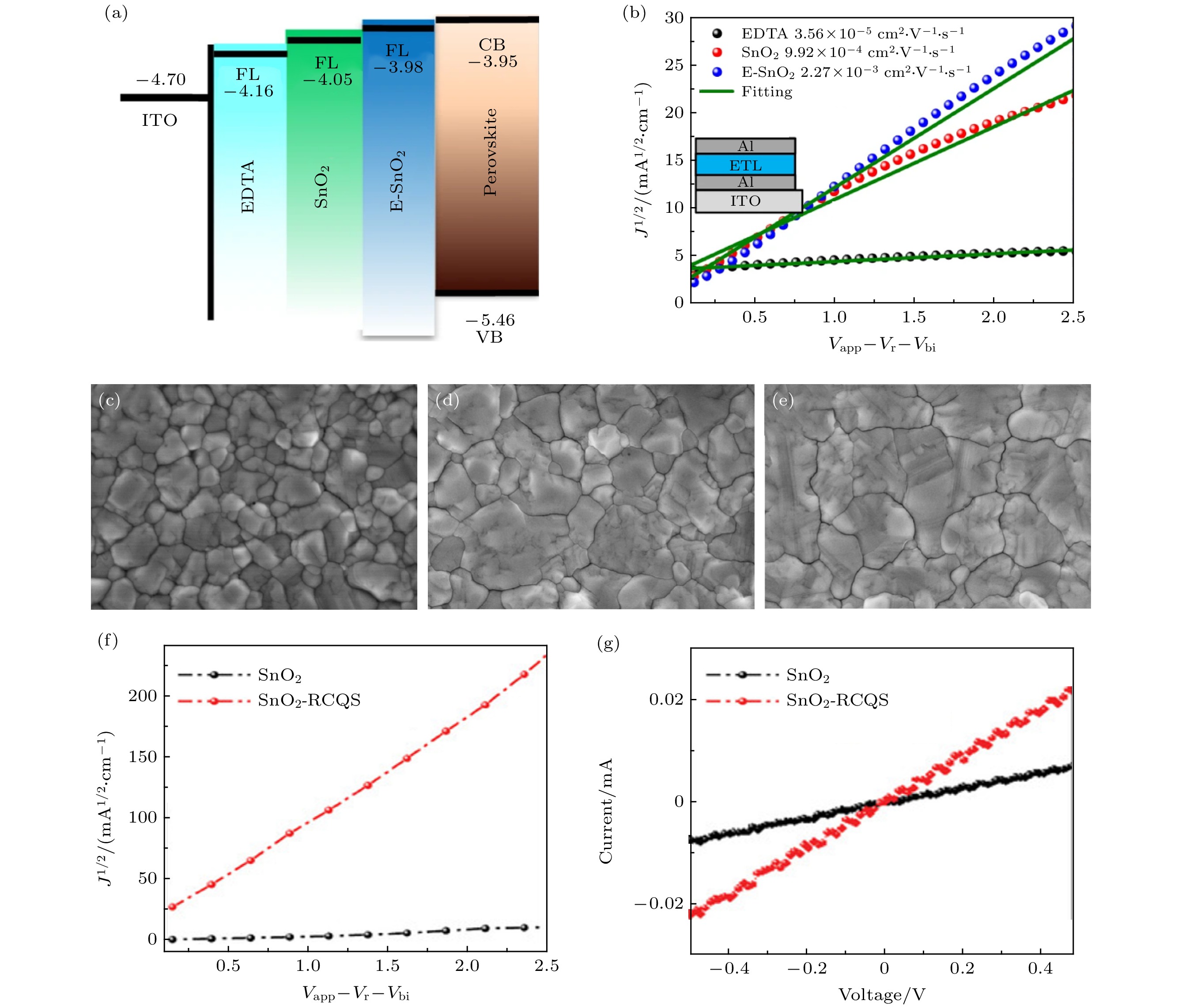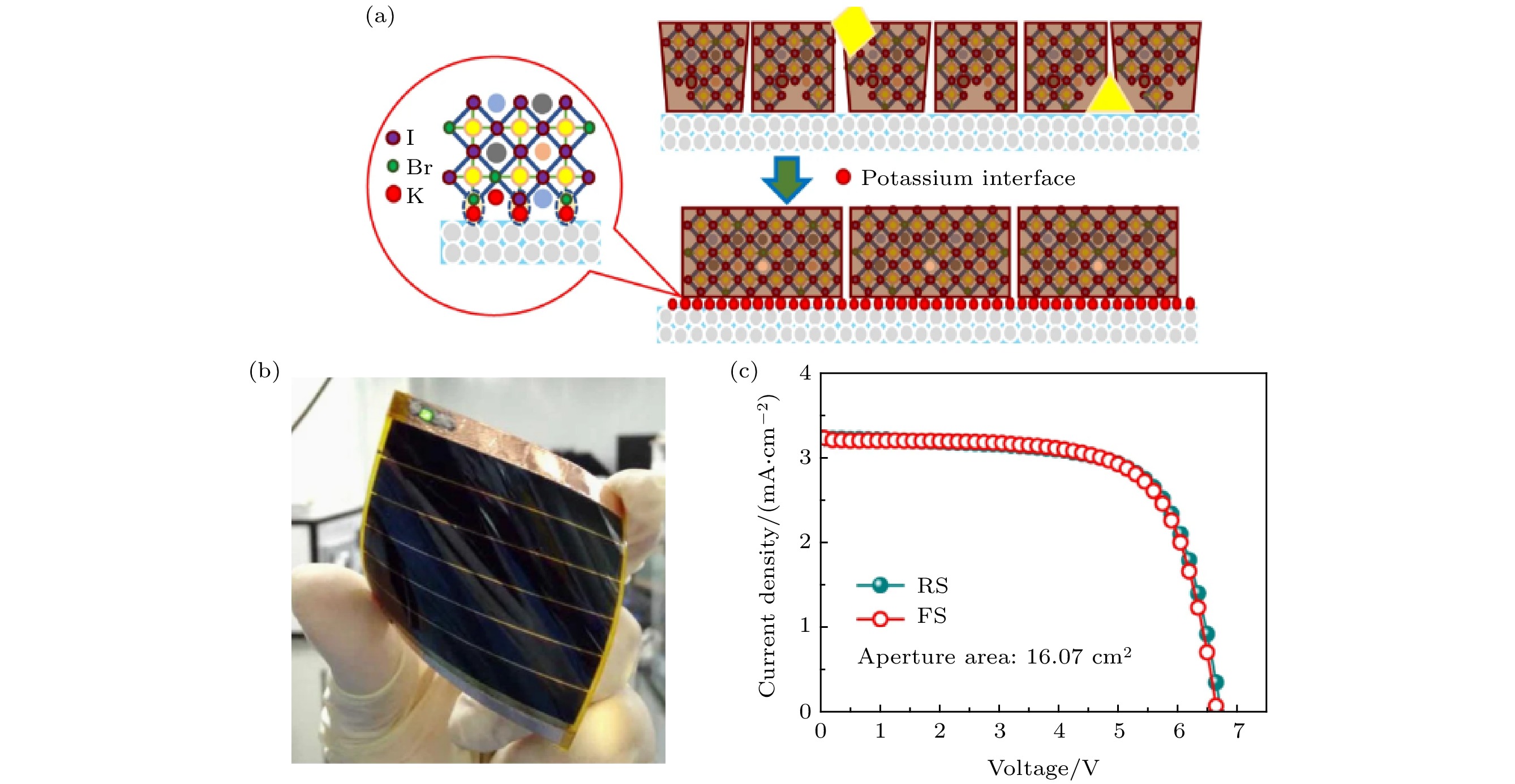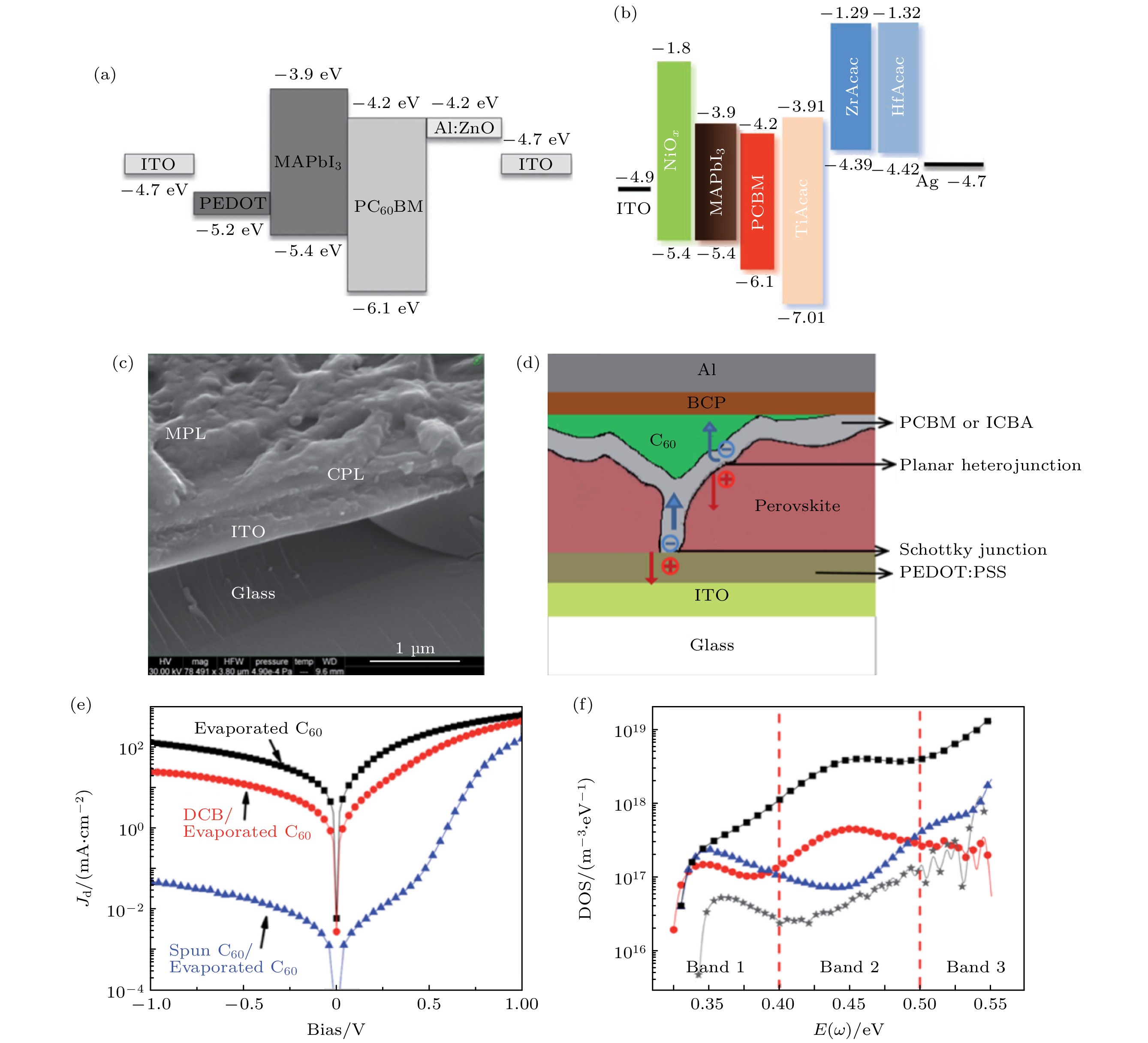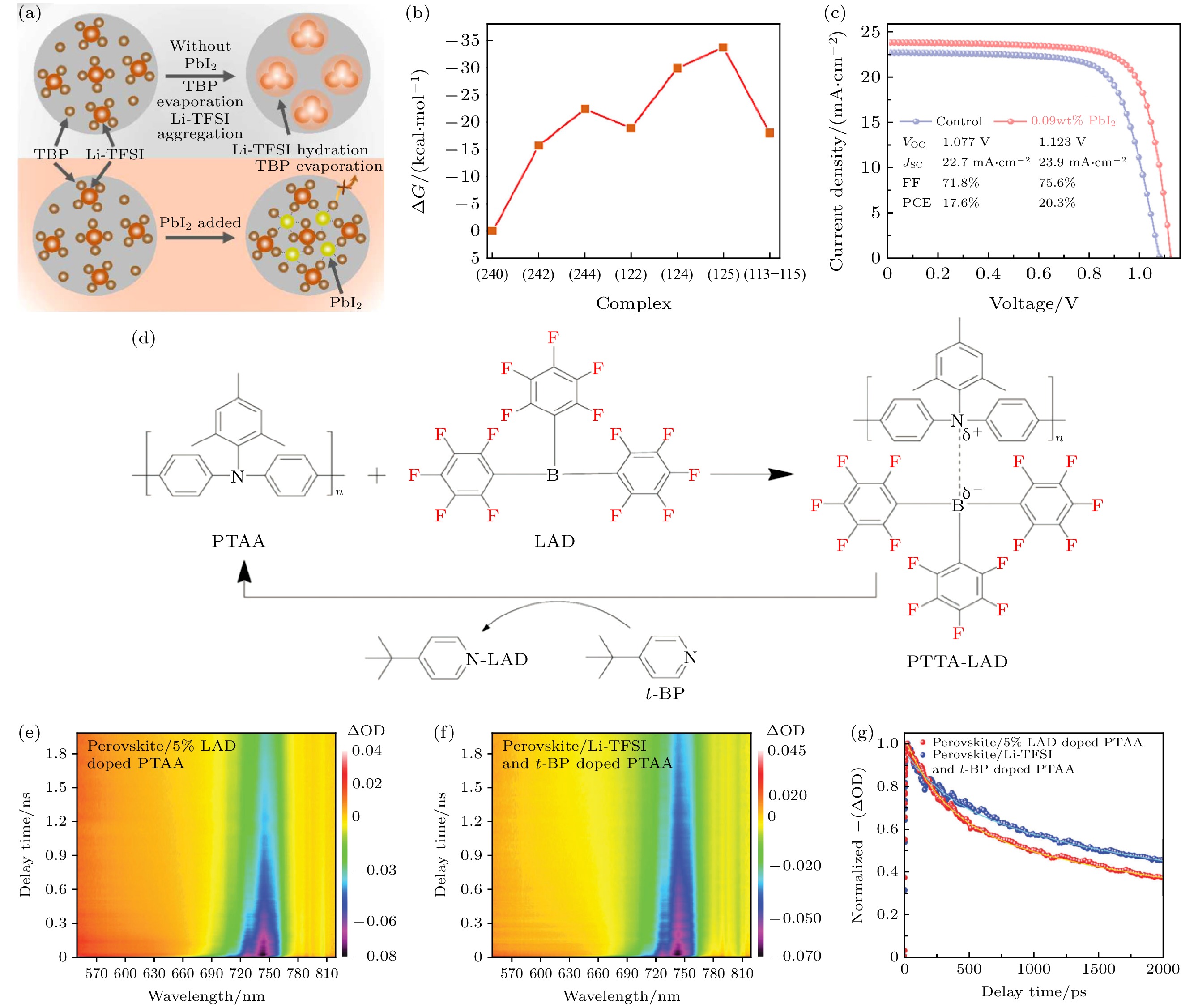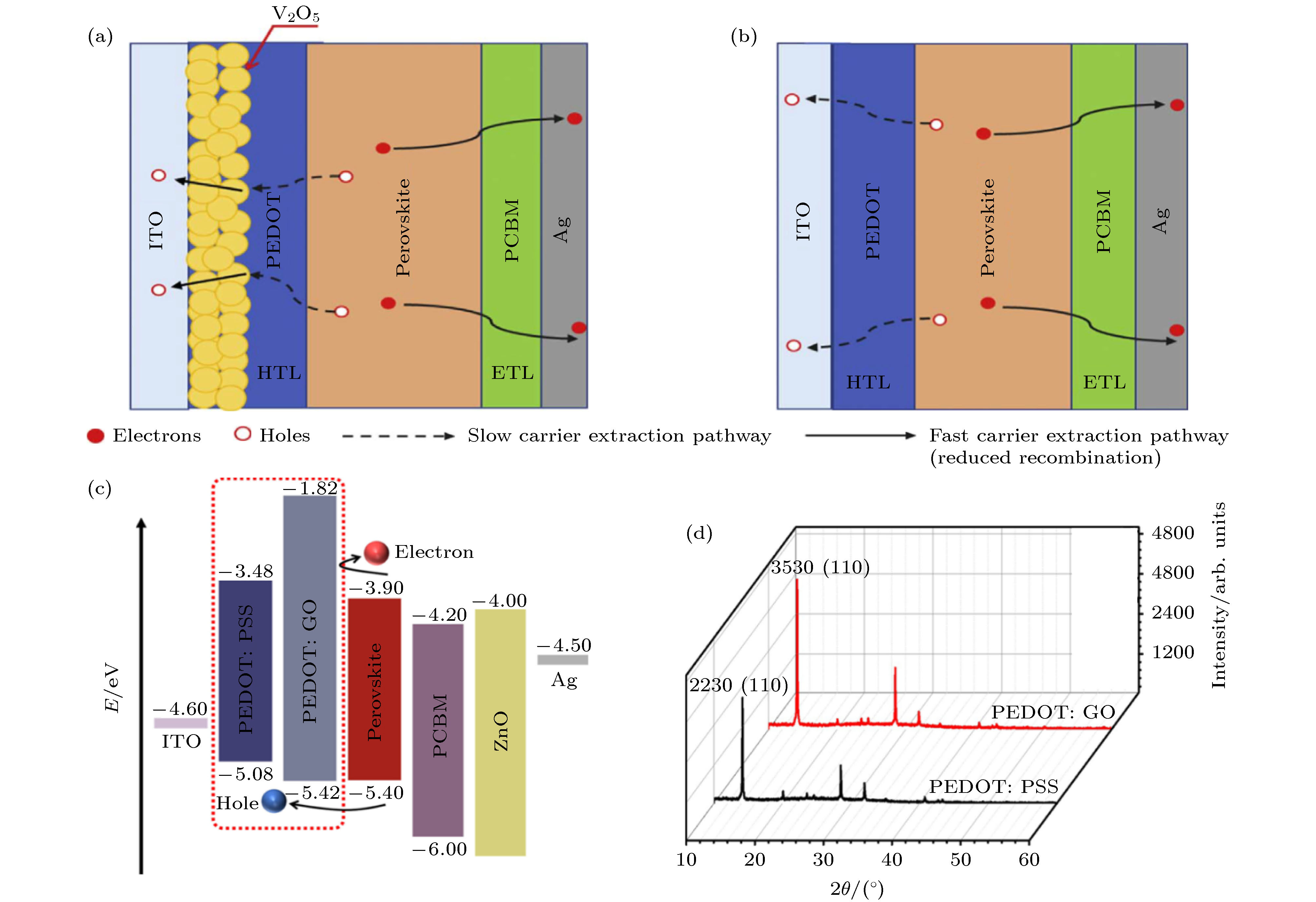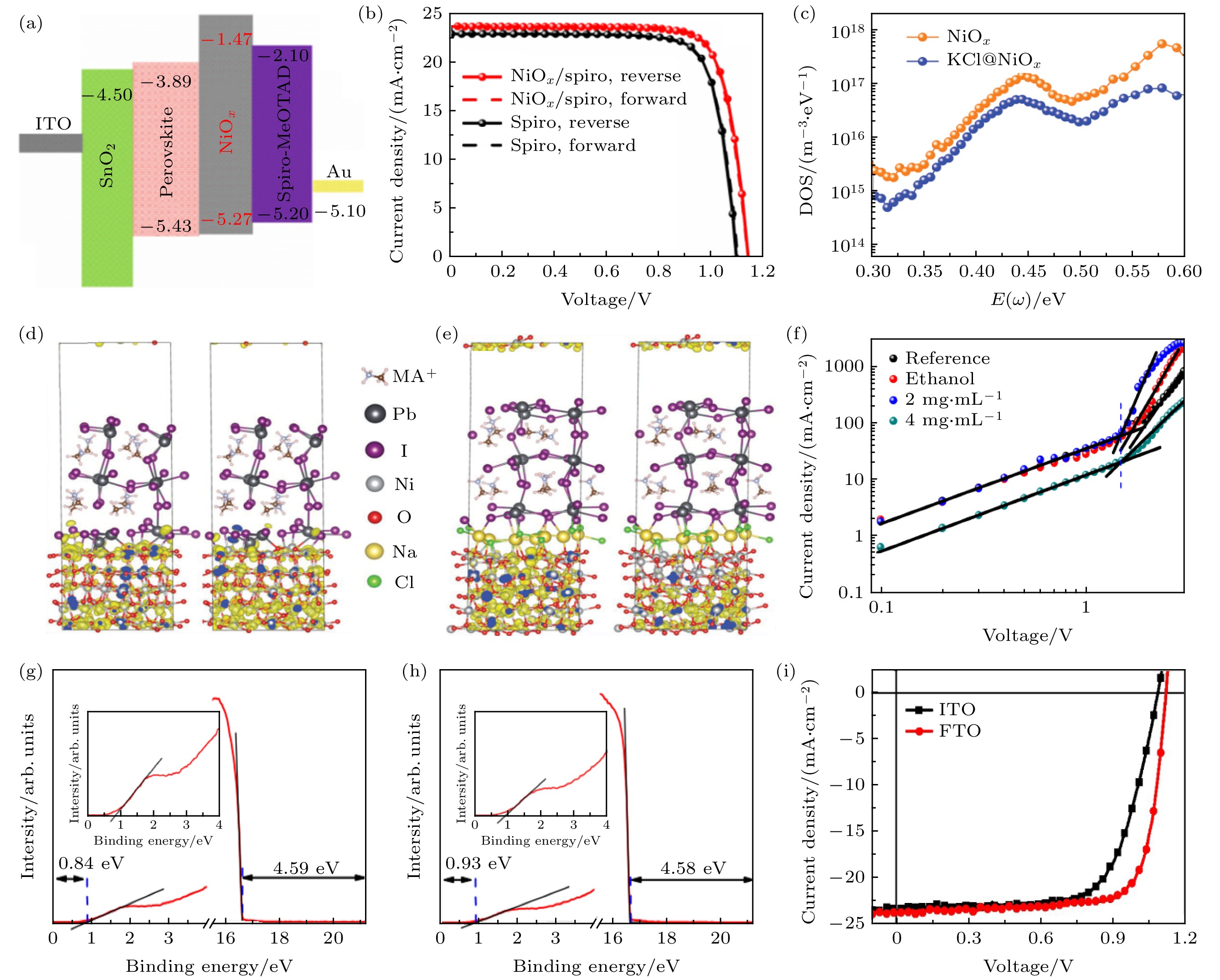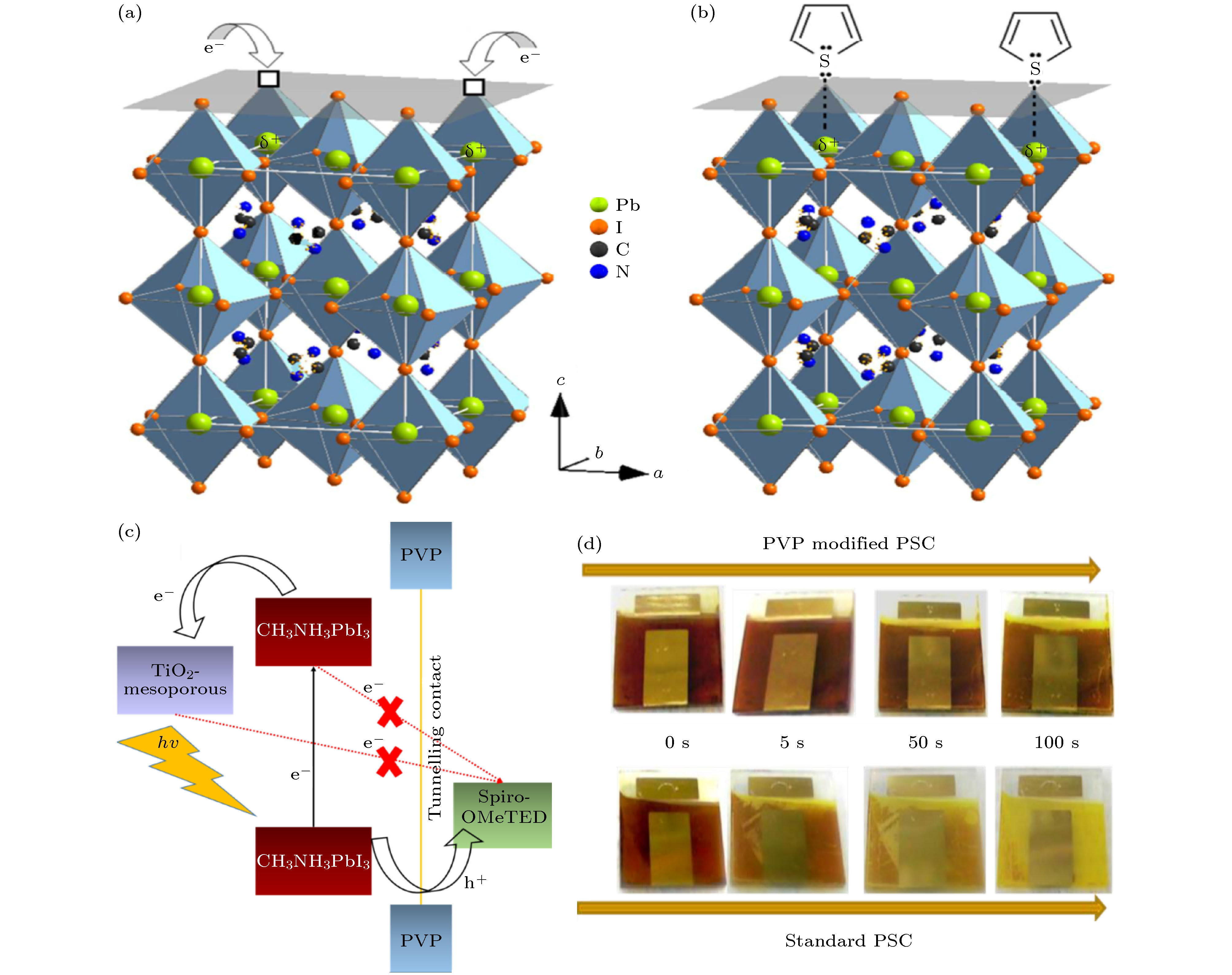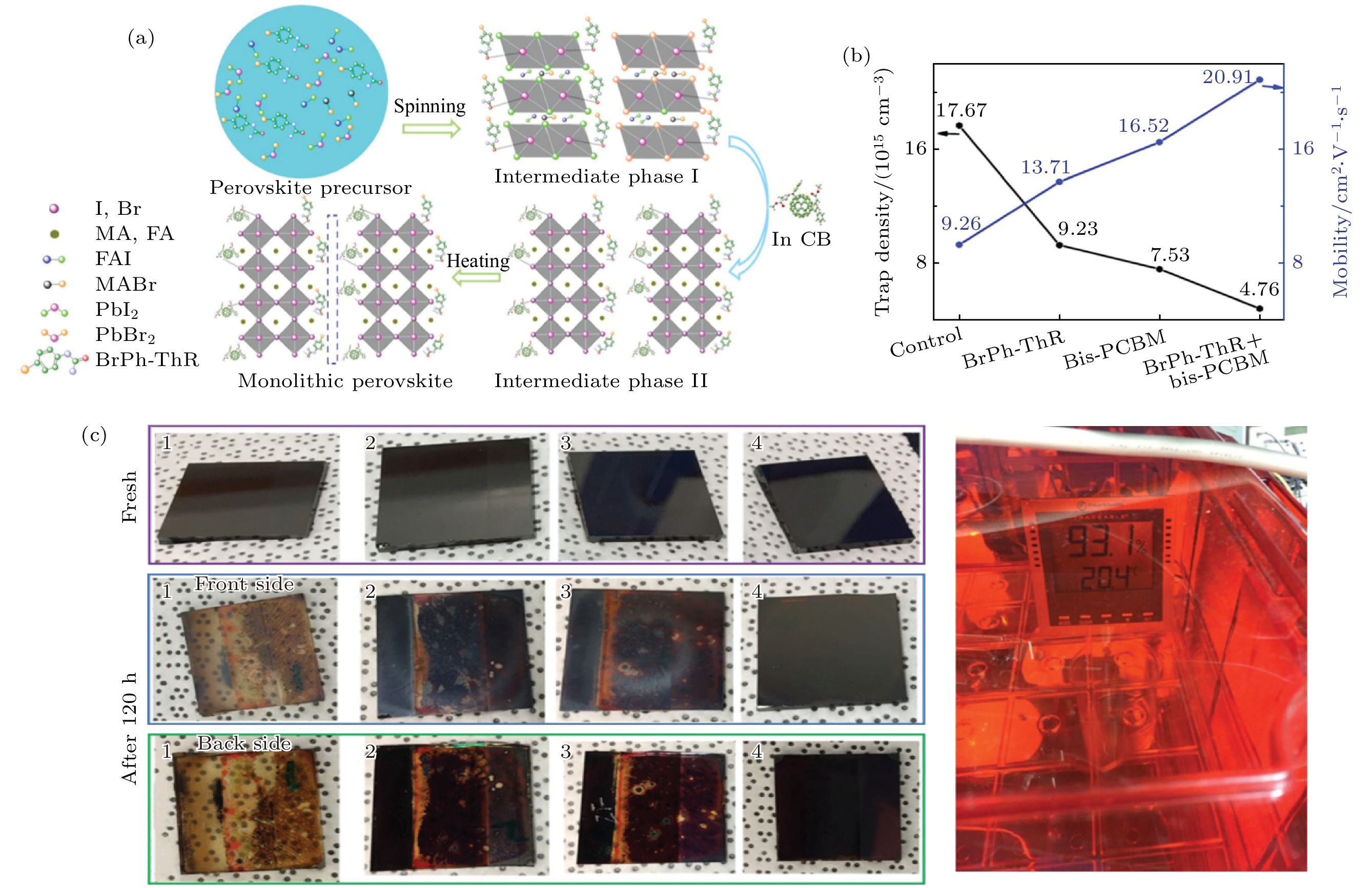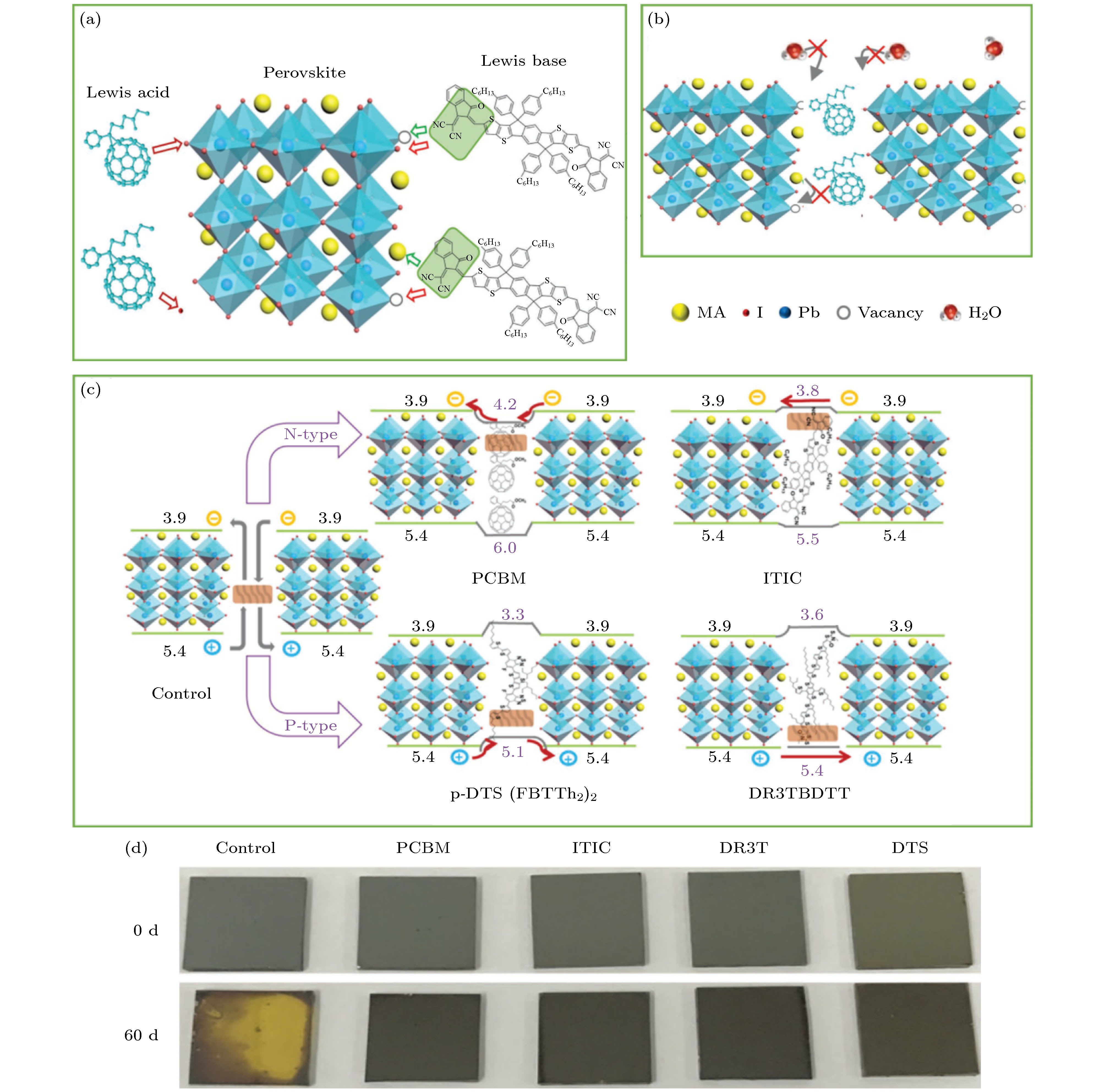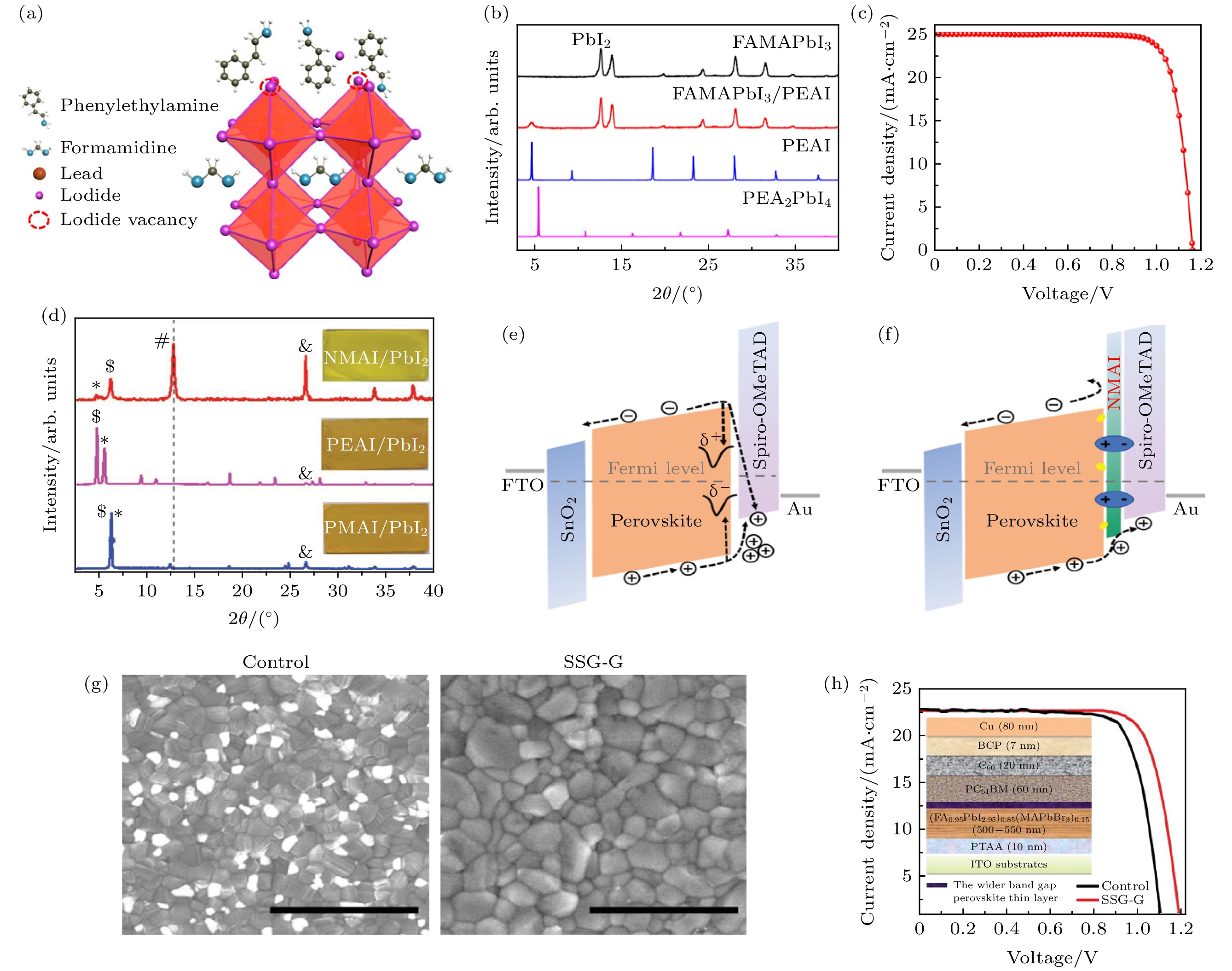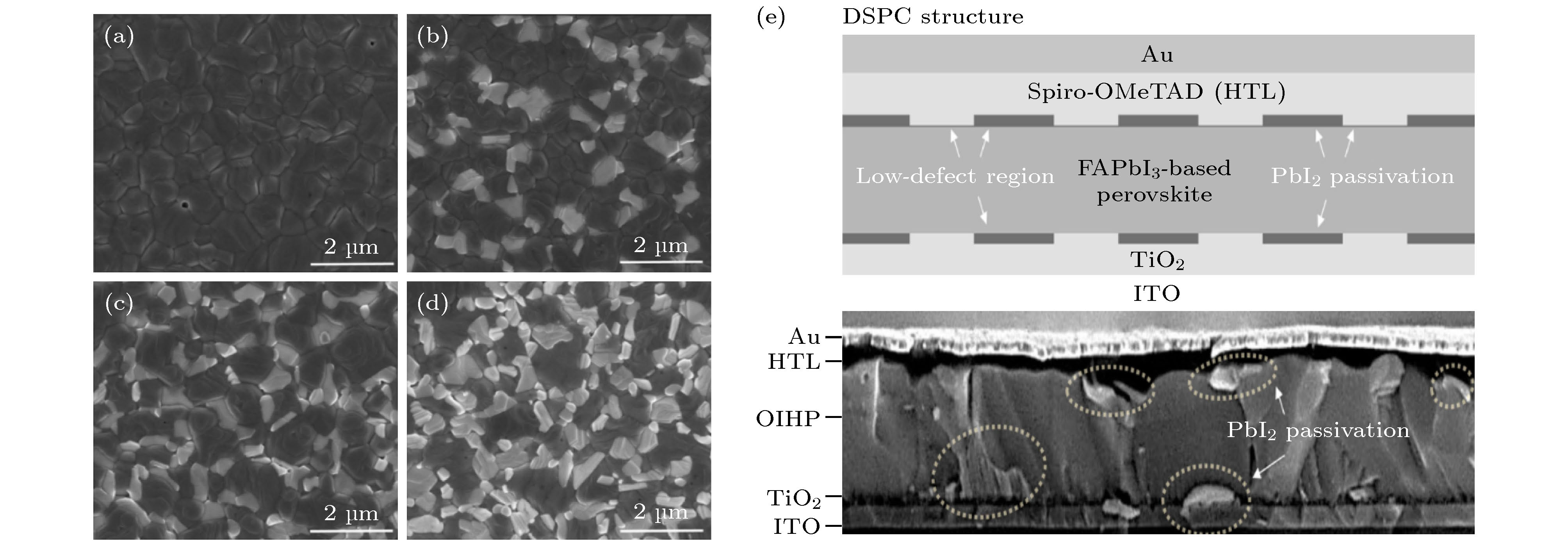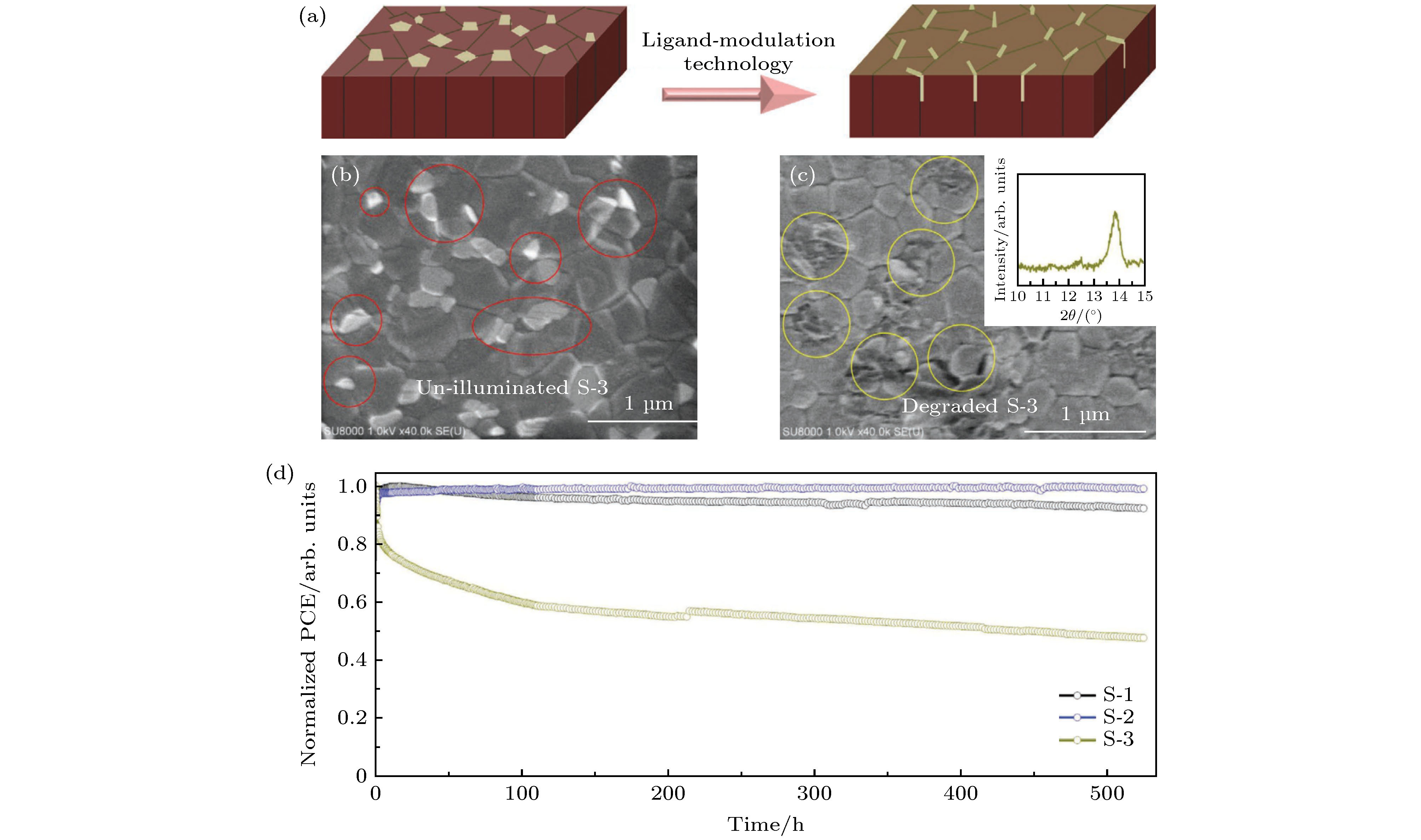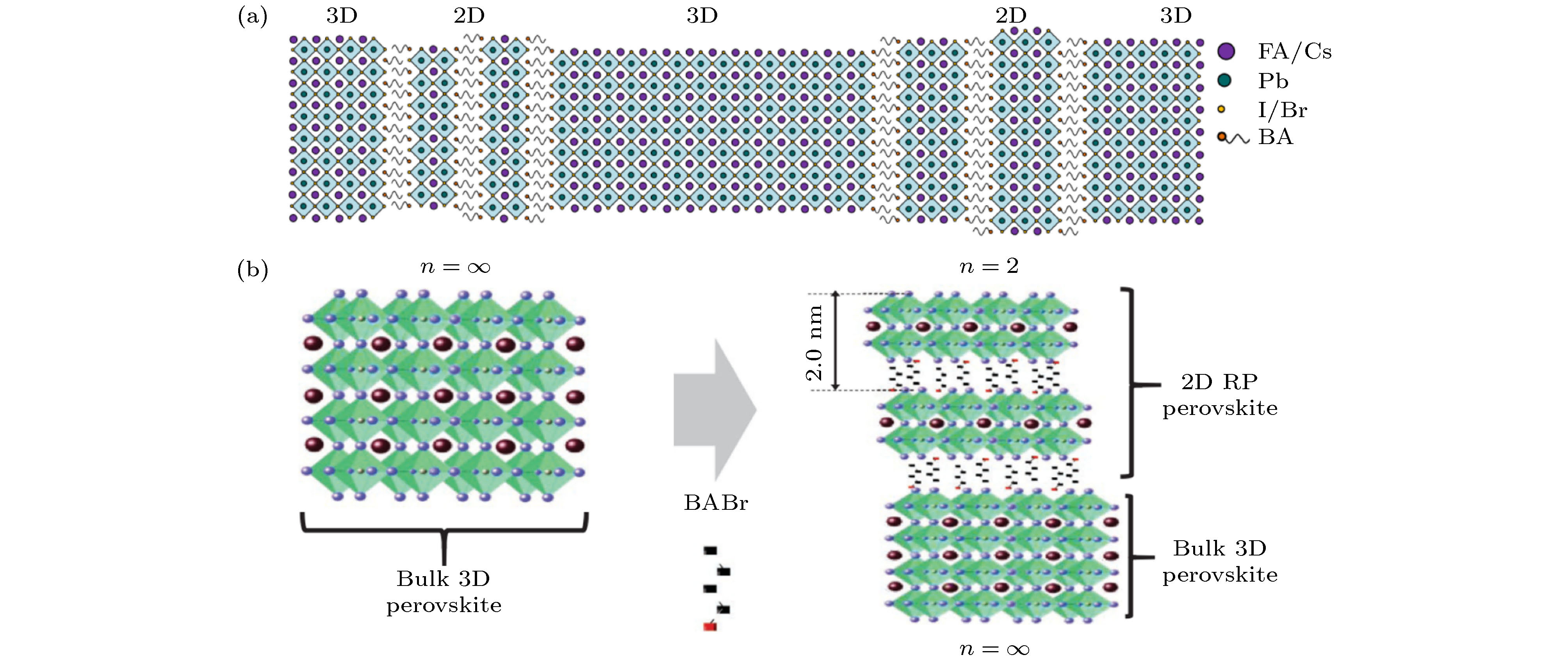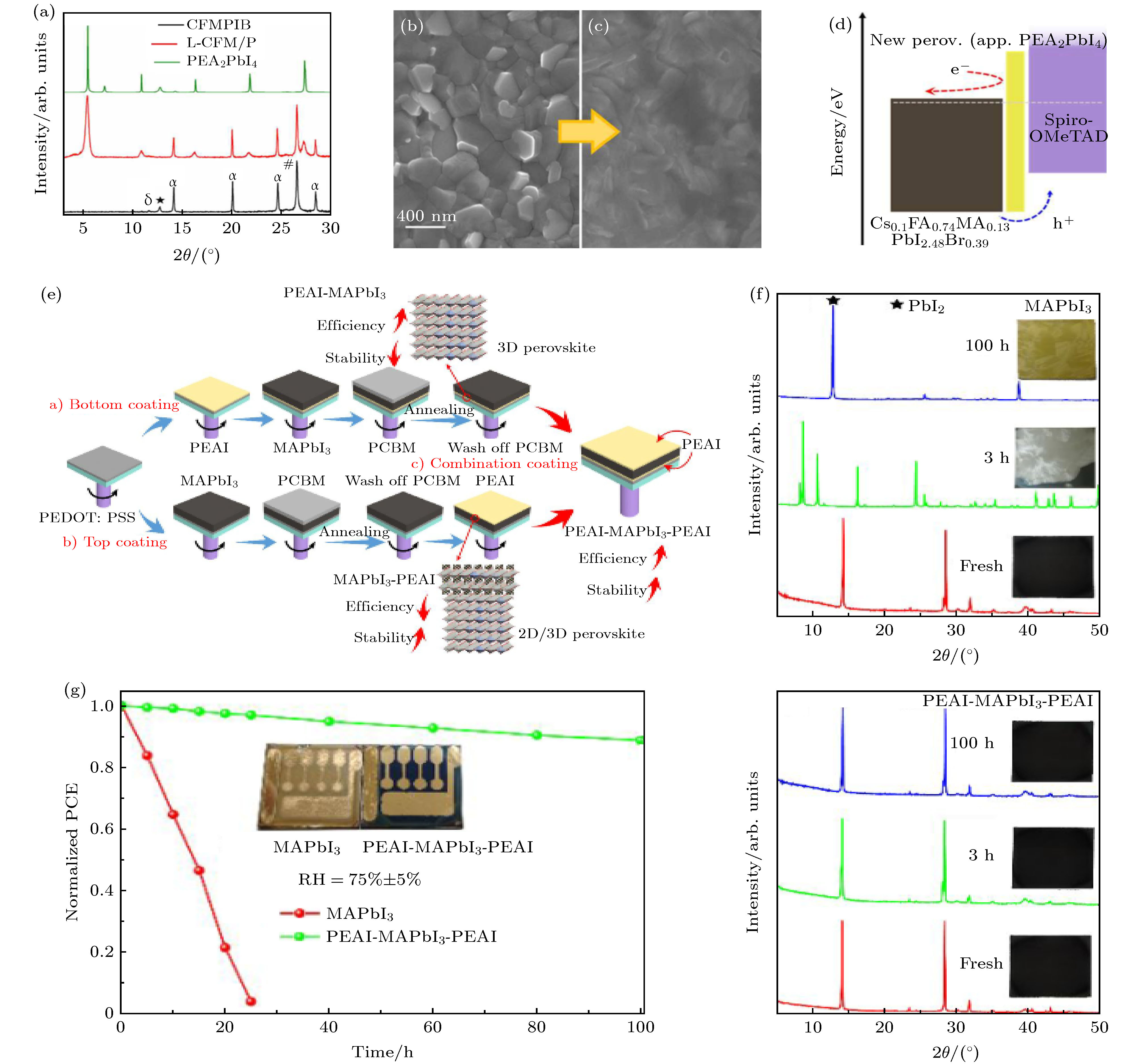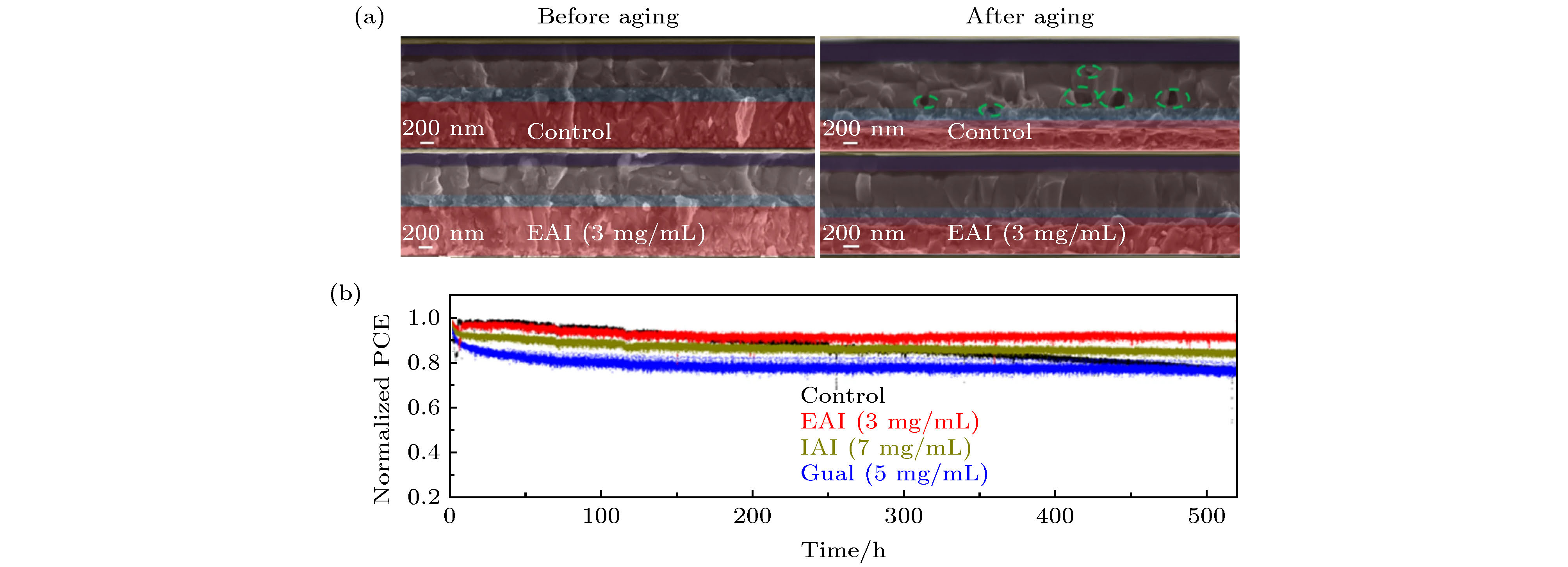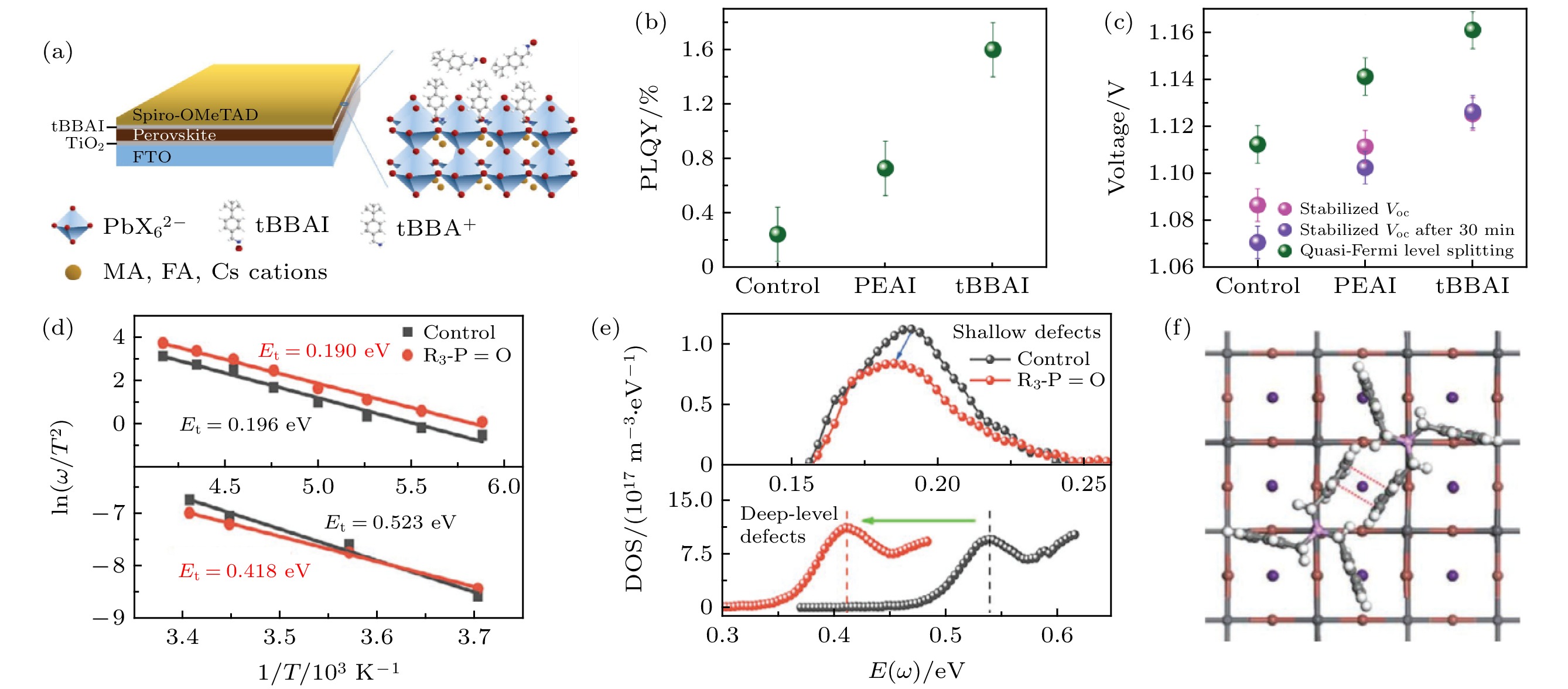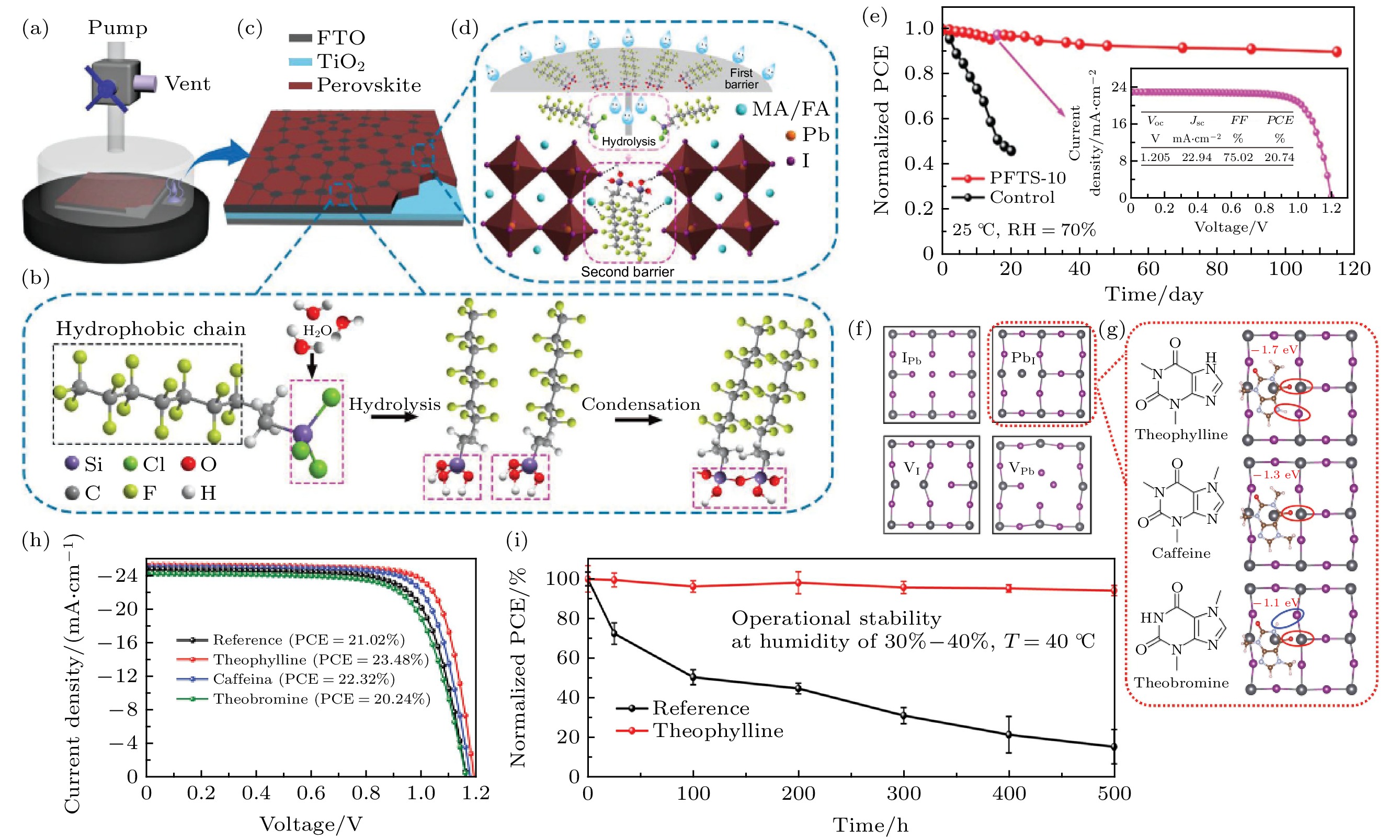-
作为近些年来最耀眼的明星材料之一, 钙钛矿以其优异独特的光电特性成功吸引研究人员的广泛关注. 自2009年报道了第一篇光电转换效率为3.8%的钙钛矿电池, 到现在短短10年期间效率已经突破25.2%,几乎可以与商用多晶硅电池媲美. 尽管其制备过程简单, 但在薄膜的形成过程中很容易引入大量的缺陷. 缺陷的存在会加速载流子的复合, 阻碍载流子传输通道, 不利于制备高效率的钙钛矿太阳能电池; 同时也会影响钙钛矿电池工作的长期稳定性, 加速材料的降解, 阻碍了钙钛矿太阳能电池进一步商业化发展. 因此, 理解缺陷的存在机制并有效地抑制缺陷产生, 对制备高性能长寿命器件至关重要. 而界面修饰作为一种有效的钝化缺陷方法之一, 已经被广泛使用. 本文讨论了不同结构电池器件的缺陷产生位置及对器件性能的影响. 分别从载流子传输层钝化策略和钙钛矿界面修饰策略入手, 分析了常用的传输层/钙钛矿界面钝化缺陷的机制, 指出了钝化策略发展的巨大优势, 并对合适的钝化材料进行分类, 希望能够对高重复性、高光电转换效率、长期工作稳定的钙钛矿太阳能电池发展提供有益的指导.As one of the most dazzling star materials in recent years, perovskite has attracted extensive attention due to its unique photoelectric properties. Since the first report on 3.8% power conversion efficiency of perovskite solar cells (PSCs) was published in 2009, its efficiency has increased to 25.2% in a short period of 10 years, almost comparable to the efficiency of commercial polysilicon cells. However, due to its simple preparation process, it is easy to introduce a large number of defects in the film formation process. The defects accelerate the recombination of carriers and thus hindering the carrier transport channel, which is unfavorable for the preparation of high efficiency perovskite solar cells. Moreover, the existence of defects will affect the stability of PSCs, accelerate the degradation of materials, thereby hindering its further commercial development. Therefore, it is very important to understand the mechanism of defects and effectively suppress the generation of defects for the fabrication of high performance devices. As an effective passivation strategy, the interface modification has been widely used. In this paper, the locations of defects in different structures of devices and their effects on device performance are discussed. Based on the carrier transport layer passivation strategy and perovskite interface modification strategy, the mechanism of the passivation defects at the transport layer/perovskite interface is analyzed. The great advantages of passivation strategy and the classification of appropriate passivation materials are pointed out. It is hoped that this paper can provide useful guidance for developing the perovskite solar cells with high repeatability, high efficiency and long-term stability.
-
Keywords:
- perovskite solar cell /
- interface passivation /
- high efficiency /
- stability
[1] Kojima A, Teshima K, Shirai Y, Miyasaka T 2009 J. Am. Chem. Soc. 131 6050
 Google Scholar
Google Scholar
[2] Kim H S, Lee C R, Im J H, Lee K B, Moehl T, Marchioro A, Moon S J, Humphry-Baker R, Yum J H, Moser J E, Grätzel M, Park N G 2012 Sci. Rep. 2 591
 Google Scholar
Google Scholar
[3] Lee M M, Teuscher J, Miyasaka T, Murakami T N, Snaith H J 2012 Science 338 643
 Google Scholar
Google Scholar
[4] Zhou H, Chen Q, Li G, Luo S, Song T b, Duan H S, Hong Z, You J, Liu Y, Yang Y 2014 Science 345 542
 Google Scholar
Google Scholar
[5] Leijtens T, Bush K A, Prasanna R, McGehee M D 2018 Nat. Energy 3 828
 Google Scholar
Google Scholar
[6] Yang W S, Noh J H, Jeon N J, Kim Y C, Ryu S, Seo J, Seok S I 2015 Science 348 1234
 Google Scholar
Google Scholar
[7] García de Arquer F P, Armin A, Meredith P, Sargent E H 2017 Nat. Rev. Mater. 2 16100
 Google Scholar
Google Scholar
[8] Dou L, Yang Y, You J, Hong Z, Chang W H, Li G, Yang Y 2014 Nat. Commun. 5 5404
 Google Scholar
Google Scholar
[9] Jiang Y, Qin C, Cui M, He T, Liu K, Huang Y, Luo M, Zhang L, Xu H, Li S, Wei J, Liu Z, Wang H, Kim G H, Yuan M, Chen J 2019 Nat. Commun. 10 1868
 Google Scholar
Google Scholar
[10] Tan Z K, Moghaddam R S, Lai M L, Docampo P, Higler R, Deschler F, Price M, Sadhanala A, Pazos L M, Credgington D, Hanusch F, Bein T, Snaith H J, Friend R H 2014 Nat. Nanotechnol. 9 687
 Google Scholar
Google Scholar
[11] Chen B, Rudd P N, Yang S, Yuan Y, Huang J 2019 Chem. Soc. Rev. 48 3842
 Google Scholar
Google Scholar
[12] Saliba M, Matsui T, Domanski K, Seo J Y, Ummadisingu A, Zakeeruddin S M, Correa-Baena J P, Tress W R, Abate A, Hagfeldt A, Grätzel M 2016 Science 354 206
 Google Scholar
Google Scholar
[13] Si H, Zhang Z, Liao Q, Zhang G, Ou Y, Zhang S, Wu H, Wu J, Kang Z, Zhang Y 2020 Adv. Mater. 32 1904702
 Google Scholar
Google Scholar
[14] Lu C H, Biesold-McGee G V, Liu Y, Kang Z, Lin Z 2020 Chem. Soc. Rev. 49 4953
 Google Scholar
Google Scholar
[15] Zhao Y, Liang C, Zhang H, Li D, Tian D, Li G, Jing X, Zhang W, Xiao W, Liu Q, Zhang F, He Z 2015 Energ Environ. Sci. 8 1256
 Google Scholar
Google Scholar
[16] Zhao Y, Zhou W, Ma W, Meng S, Li H, Wei J, Fu R, Liu K, Yu D, Zhao Q 2016 ACS Energy Lett. 1 266
 Google Scholar
Google Scholar
[17] Liu M, Johnston M B, Snaith H J 2013 Nature 501 395
 Google Scholar
Google Scholar
[18] Ji C, Liang C, Zhang H, Sun M, Song Q, Sun F, Feng X, Liu N, Gong H, Li D, You F, He Z 2020 ACS Appl. Mater. Interfaces 12 20026
 Google Scholar
Google Scholar
[19] Jeon N J, Noh J H, Yang W S, Kim Y C, Ryu S, Seo J, Seok S I 2015 Nature 517 476
 Google Scholar
Google Scholar
[20] Jeon N J, Noh J H, Kim Y C, Yang W S, Ryu S, Seok S I 2014 Nat. Mater. 13 897
 Google Scholar
Google Scholar
[21] Seok S I, Grätzel M, Park N G 2018 Small 14 1704177
 Google Scholar
Google Scholar
[22] Du Y, Cai H, Wu Y, Xing Z, Li Z, Xu J, Huang L, Ni J, Li J, Zhang J 2017 Phys. Chem. Chem. Phys. 19 13679
 Google Scholar
Google Scholar
[23] Nowotny J, Alim M A, Bak T, Idris M A, Ionescu M, Prince K, Sahdan M Z, Sopian K, Mat Teridi M A, Sigmund W 2015 Chem. Soc. Rev. 44 8424
 Google Scholar
Google Scholar
[24] Du B, Zhao D, Hou Z, Zheng L, Liu X, Chen D, Gao C, Yun D 2019 Chinese Sci. Bull. 64 1887
 Google Scholar
Google Scholar
[25] Jiang L L, Wang Z K, Li M, Li C H, Fang P F, Liao L S 2018 Sol. RRL 2 1800149
 Google Scholar
Google Scholar
[26] Tan H, Jain A, Voznyy O, Lan X, García de Arquer F P, Fan J Z, Quintero-Bermudez R, Yuan M, Zhang B, Zhao Y, Fan F, Li P, Quan L N, Zhao Y, Lu Z H, Yang Z, Hoogland S, Sargent E H 2017 Science 355 722
 Google Scholar
Google Scholar
[27] Shi X, Ding Y, Zhou S, Zhang B, Cai M, Yao J, Hu L, Wu J, Dai S, Nazeeruddin M K 2019 Adv. Sci. 6 1901213
 Google Scholar
Google Scholar
[28] Yang D, Yang R, Wang K, Wu C, Zhu X, Feng J, Ren X, Fang G, Priya S, Liu S 2018 Nat. Commun. 9 3239
 Google Scholar
Google Scholar
[29] Hui W, Yang Y, Xu Q, Gu H, Feng S, Su Z, Zhang M, Wang J, Li X, Fang J, Xia F, Xia Y, Chen Y, Gao X, Huang W 2020 Adv. Mater. 32 1906374
 Google Scholar
Google Scholar
[30] Bu T, Li J, Zheng F, Chen W, Wen X, Ku Z, Peng Y, Zhong J, Cheng Y B, Huang F 2018 Nat. Commun. 9 4609
 Google Scholar
Google Scholar
[31] Bush K A, Bailie C D, Chen Y, Bowring A R, Wang W, Ma W, Leijtens T, Moghadam F, McGehee M D 2016 Adv. Mater. 28 3937
 Google Scholar
Google Scholar
[32] Chen W, Xu L, Feng X, Jie J, He Z 2017 Adv. Mater. 29 1603923
 Google Scholar
Google Scholar
[33] Wang Q, Shao Y, Dong Q, Xiao Z, Yuan Y, Huang J 2014 Energ Environ. Sci. 7 2359
 Google Scholar
Google Scholar
[34] Albrecht S, Saliba M, Correa Baena J P, Lang F, Kegelmann L, Mews M, Steier L, Abate A, Rappich J, Korte L, Schlatmann R, Nazeeruddin M K, Hagfeldt A, Grätzel M, Rech B 2016 Energ Environ. Sci. 9 81
 Google Scholar
Google Scholar
[35] Liu Y, Hu Y, Zhang X, Zeng P, Li F, Wang B, Yang Q, Liu M 2020 Nano Energy 70 104483
 Google Scholar
Google Scholar
[36] Luo J, Xia J, Yang H, Chen L, Wan Z, Han F, Malik H A, Zhu X, Jia C 2018 Energ Environ. Sci. 11 2035
 Google Scholar
Google Scholar
[37] Wang D, Wright M, Elumalai N K, Uddin A 2016 Sol. Energ. Mat. Sol. C. 147 255
 Google Scholar
Google Scholar
[38] Wang D, Elumalai N K, Mahmud M A, Wright M, Upama M B, Chan K H, Xu C, Haque F, Conibeer G, Uddin A 2018 Org. Electron. 53 66
 Google Scholar
Google Scholar
[39] Yu J C, Hong J A, Jung E D, Kim D B, Baek S M, Lee S, Cho S, Park S S, Choi K J, Song M H 2018 Sci. Rep. 8 1070
 Google Scholar
Google Scholar
[40] Li R, Wang P, Chen B, Cui X, Ding Y, Li Y, Zhang D, Zhao Y, Zhang X 2020 ACS Energy Lett. 5 79
 Google Scholar
Google Scholar
[41] Chen W, Zhou Y, Chen G, Wu Y, Tu B, Liu F Z, Huang L, Ng A M C, Djurišić A B, He Z 2019 Adv. Energy Mater. 9 1803872
 Google Scholar
Google Scholar
[42] Yue S, Liu K, Xu R, Li M, Azam M, Ren K, Liu J, Sun Y, Wang Z, Cao D, Yan X, Qu S, Lei Y, Wang Z 2017 Energ Environ. Sci. 10 2570
 Google Scholar
Google Scholar
[43] Aberle A G 2000 Prog. Photovolt 8 473
 Google Scholar
Google Scholar
[44] Abate A, Saliba M, Hollman D J, Stranks S D, Wojciechowski K, Avolio R, Grancini G, Petrozza A, Snaith H J 2014 Nano Lett. 14 3247
 Google Scholar
Google Scholar
[45] Noel N K, Abate A, Stranks S D, Parrott E S, Burlakov V M, Goriely A, Snaith H J 2014 ACS Nano 8 9815
 Google Scholar
Google Scholar
[46] Chaudhary B, Kulkarni A, Jena A K, Ikegami M, Udagawa Y, Kunugita H, Ema K, Miyasaka T 2017 ChemSusChem 10 2473
 Google Scholar
Google Scholar
[47] Zhang F, Bi D, Pellet N, Xiao C, Li Z, Berry J J, Zakeeruddin S M, Zhu K, Grätzel M 2018 Energ Environ. Sci. 11 3480
 Google Scholar
Google Scholar
[48] Niu T, Lu J, Munir R, Li J, Barrit D, Zhang X, Hu H, Yang Z, Amassian A, Zhao K, Liu S 2018 Adv. Mater. 30 1706576
 Google Scholar
Google Scholar
[49] Jiang Q, Zhao Y, Zhang X, Yang X, Chen Y, Chu Z, Ye Q, Li X, Yin Z, You J 2019 Nat. Photonics 13 460
 Google Scholar
Google Scholar
[50] Liang L, Luo H, Hu J, Li H, Gao P 2020 Adv. Energy Mater. 10 2000197
 Google Scholar
Google Scholar
[51] Luo D, Yang W, Wang Z, Sadhanala A, Hu Q, Su R, Shivanna R, Trindade G F, Watts J F, Xu Z, Liu T, Chen K, Ye F, Wu P, Zhao L, Wu J, Tu Y, Zhang Y, Yang X, Zhang W, Friend R H, Gong Q, Snaith H J, Zhu R 2018 Science 360 1442
 Google Scholar
Google Scholar
[52] Zou Y, Wang H Y, Qin Y, Mu C, Li Q, Xu D, Zhang J P 2019 Adv. Funct. Mater. 29 1805810
 Google Scholar
Google Scholar
[53] Wu S, Zhang J, Li Z, Liu D, Qin M, Cheung S H, Lu X, Lei D, So S K, Zhu Z, Jen A K Y 2020 Joule 4 1248
 Google Scholar
Google Scholar
[54] Jiang Q, Chu Z, Wang P, Yang X, Liu H, Wang Y, Yin Z, Wu J, Zhang X, You J 2017 Adv. Mater. 29 1703852
 Google Scholar
Google Scholar
[55] Zhao Y, Li Q, Zhou W, Hou Y, Zhao Y, Fu R, Yu D, Liu X, Zhao Q 2019 Sol. RRL 3 1800296
 Google Scholar
Google Scholar
[56] Wang H, Wang Z, Yang Z, Xu Y, Ding Y, Tan L, Yi C, Zhang Z, Meng K, Chen G, Zhao Y, Luo Y, Zhang X, Hagfeldt A, Luo J 2020 Adv. Mater. 32 2000865
 Google Scholar
Google Scholar
[57] Tumen-Ulzii G, Qin C, Klotz D, Leyden M R, Wang P, Auffray M, Fujihara T, Matsushima T, Lee J W, Lee S J, Yang Y, Adachi C 2020 Adv. Mater. 32 1905035
 Google Scholar
Google Scholar
[58] Wang Z, Lin Q, Chmiel F P, Sakai N, Herz L M, Snaith H J 2017 Nat. Energy 2 17135
 Google Scholar
Google Scholar
[59] Gharibzadeh S, Abdollahi Nejand B, Jakoby M, Abzieher T, Hauschild D, Moghadamzadeh S, Schwenzer J A, Brenner P, Schmager R, Haghighirad A A, Weinhardt L, Lemmer U, Richards B S, Howard I A, Paetzold U W 2019 Adv. Energy Mater. 9 1803699
 Google Scholar
Google Scholar
[60] Cho K T, Grancini G, Lee Y, Oveisi E, Ryu J, Almora O, Tschumi M, Schouwink P A, Seo G, Heo S, Park J, Jang J, Paek S, Garcia-Belmonte G, Nazeeruddin M K 2018 Energ Environ. Sci. 11 952
 Google Scholar
Google Scholar
[61] Zhang Y, Jang S, Hwang I W, Jung Y K, Lee B R, Kim J H, Kim K H, Park S H 2020 ACS Appl. Mater. Interfaces 12 24827
 Google Scholar
Google Scholar
[62] Alharbi E A, Alyamani A Y, Kubicki D J, Uhl A R, Walder B J, Alanazi A Q, Luo J, Burgos-Caminal A, Albadri A, Albrithen H, Alotaibi M H, Moser J E, Zakeeruddin S M, Giordano F, Emsley L, Grätzel M 2019 Nat. Commun. 10 3008
 Google Scholar
Google Scholar
[63] Liu Y, Akin S, Pan L, Uchida R, Arora N, Milić J V, Hinderhofer A, Schreiber F, Uhl A R, Zakeeruddin S M, Hagfeldt A, Dar M I, Grätzel M 2019 Sci. Adv. 5 eaaw2543
 Google Scholar
Google Scholar
[64] Lv Y, Ma H, Yin Y, Dong Q, Zhao W, Jin S, Shi Y 2020 J. Mater. Chem. A 8 10283
 Google Scholar
Google Scholar
[65] Zhu H, Liu Y, Eickemeyer F T, Pan L, Ren D, Ruiz-Preciado M A, Carlsen B, Yang B, Dong X, Wang Z, Liu H, Wang S, Zakeeruddin S M, Hagfeldt A, Dar M I, Li X, Grätzel M 2020 Adv. Mater. 32 1907757
 Google Scholar
Google Scholar
[66] Li H, Shi J, Deng J, Chen Z, Li Y, Zhao W, Wu J, Wu H, Luo Y, Li D, Meng Q 2020 Adv. Mater. 32 1907396
 Google Scholar
Google Scholar
[67] Guo P, Ye Q, Liu C, Cao F, Yang X, Ye L, Zhao W, Wang H, Li L, Wang H 2020 Adv. Funct. Mater. 30 2002639
 Google Scholar
Google Scholar
[68] Wang R, Xue J, Wang K L, Wang Z K, Luo Y, Fenning D, Xu G, Nuryyeva S, Huang T, Zhao Y, Yang J L, Zhu J, Wang M, Tan S, Yavuz I, Houk K N, Yang Y 2019 Science 366 1509
 Google Scholar
Google Scholar
[69] Arora N, Dar M I, Hinderhofer A, Pellet N, Schreiber F, Zakeeruddin S M, Grätzel M 2017 Science 358 768
 Google Scholar
Google Scholar
[70] Kim Y C, Yang T Y, Jeon N J, Im J, Jang S, Shin T J, Shin H W, Kim S, Lee E, Kim S, Noh J H, Seok S I, Seo J 2017 Energ Environ. Sci. 10 2109
 Google Scholar
Google Scholar
-
图 1 (a) 掺杂H2PtCl6的TiO2前体溶液示意图; (b) 沉积在纯TiO2上的钙钛矿的SEM图像; (c)沉积在掺杂H2PtCl6的TiO2薄膜上的钙钛矿的SEM图像[25]
Fig. 1. (a) A schematic diagram of the precursor solutions of TiO2 and doped with H2PtCl6; (b) SEM image of perovskite deposited on the pure TiO2; (c) SEM image of perovskite deposited on the TiO2 film doped with H2PtCl6[25].
图 2 Cl元素对钙钛矿与TiO2界面质量的影响, Cl覆盖TiO2(TiO2-Cl)胶状纳米晶体的稳定性 (a)没有Cl元素修饰时, 在价带附近处TiO2/钙钛矿界面处存在PbI2反位缺陷; (b) 有Cl掺杂时在界面存在浅能级和非定域Pb-Cl反位缺陷; (c) TiO2薄膜的Cl-2p的XPS谱, 合成方法: 在甲醇和氯仿(MeOH+CF)的混合溶剂中重新分散, 在乙醇中以二异丙醇钛双(乙酰丙酮)作为稳定剂(EtOH+TiAcAc)再分散; (d) TiO2-Cl薄膜在不同退火温度下的Cl-2p峰的XPS谱; (e)在ITO衬底上的TiO2-Cl薄膜的SEM图像; (f)在TiO2-Cl衬底上的钙钛矿薄膜的SEM图像[26]; (g) 晶格中的O空位产生了Ti缺陷, 形成了深电子陷阱; (h) B取代缺陷Ti的位置来钝化缺陷; TiO2(i)和B-TiO2 (j)结构的结合能和相应的微分电荷密度[27]
Fig. 2. The effect of Cl on interface quality between perovskite and TiO2, and stabilization of Cl-capped TiO2 (TiO2-Cl) colloidal nanocrystals: (a)Trap-like localized antisite defects form near the valence band edge for the PbI2-terminated TiO2/perovskite interface; (b) shallow and delocalized Pb-Cl antisite defects found for the PbCl2-terminated interface; XPS spectra of Cl 2p peaks of (c) TiO2 NC films [as-synthesized, redispersed in the cosolvent of methanol and chloroform (MeOH + CF), and redispersed in ethanol with titanium diisopropoxide bis(acetylacetonate) as stabilizer (EtOH + TiAcAc)] and (d) TiO2-Cl NC films with various post-annealing temperatures; (e) top-view SEM image of the TiO2-Cl film on an ITO substrate; (f) top-view SEM image of the perovskite film on TiO2-Cl[26]; (g) oxygen vacancies in the lattice give rise to Ti defects that form deep electronic traps; (h) boron substitution in the Ti sites passivating these defects; binding energy and corresponding differential charge densities of TiO2(i)和B-TiO2 (j)[27].
图 3 (a) EDTA, SnO2, E-SnO2和钙钛矿层的能级示意图; (b)用SCLC模型研究了EDTA, SnO2, E-SnO2的电子迁移率, 插图显示了ITO/Al/ETL/Al的器件结构. (c)—(e)SnO2, EDTA, E-SnO2衬底上钙钛矿薄膜的SEM图像[28]; (f)基于SnO2-RCQ和SnO2的单载流子电子器件的J-V特性, 根据这些特性, 从中计算出它们的电子迁移率; (g)有无RCQ的SnO2薄膜的导电特性[29]
Fig. 3. (a) Schematic illustration of Fermi level of EDTA, SnO2, and E-SnO2 relative to the conduction band of the perovskite layer; (b) electron mobility for EDTA, SnO2, and E-SnO2 using the SCLC model, and the inset shows the device structure of ITO/Al/ETL/Al; (c)–(e) top-view scanning electron microscope (SEM) images of perovskite films coated on SnO2, EDTA, and E-SnO2 substrates[28]; (f) J-V characteristics of the electron-only devices based on the SnO2-RCQs and SnO2 ETLs, from which their electron mobility was calculated from the SCLC model; (g) Conduction properties of the SnO2 films with and without RCQs[29].
图 5 (a), (b) 倒置结构钙钛矿太阳能电池能带图示意图[31,32]; (c)溶液制备钙钛矿薄膜的斜截面扫描电镜图像, 对连续钙钛矿层(CPL)和微观结构钙钛矿层(MPL)进行了标记. 比例尺为1 μm; (d)钙钛矿双层富勒烯钝化的结构示意图; (e)不同富勒烯层制备工艺的钙钛矿型器件的暗电流; (f)单PCBM层(蓝色三角形)、单C60层(红点)、PCBM/C60双富勒烯层(灰星)钝化的器件的陷阱态密度(tDOS); 黑色方块表示没有富勒烯钝化的器件[33]
Fig. 5. (a), (b) Schematic drawing of the band energy diagrams for the inverted structure perovskite solar cell[31,32]. (c) Tilted cross-section SEM image of a perovskite film. The continuous perovskite layer (CPL) and the microstructure perovskite layer (MPL) are labeled. The scale bar is 1 μm. (d) The schematic device structure of the perovskite PV devices. An ICBA or PCBM layer is sketched as a conformal layer and the two types of junction are also depicted. The thickness of the each layer is not in scale with the real thickness for clarity. (e) Dark current of perovskite devices with different fullerene layer fabrication processes. (f) Trap density of states (tDOS) for devices passivated by single PCBM layer (blue triangles), single C60 layer (red dots), PCBM/C60 double fullerene layers (grey stars); black squares represent the devices without fullerene passivation[33].
图 6 (a)PbI2防止Li-TFSI团聚作用的示意图; (b)计算的各种配合物(PbαIβ·γTBP)缩写为(αβγ)的吉布斯自由能(ΔG)数值; (c)原始和优化器件的电流密度-电压(J-V)曲线[35]; (d)PTAA和LAD的分子结构, 以及Lewis碱性PTAA与Lewis酸性LAD在溶液中的可逆反应; (e)双层结构的钙钛矿/5%LAD掺杂PTAA和(f)钙钛矿/Li-TFSI和tBP共掺杂PTAA薄膜在365 nm激发下的飞秒超快光谱研究; (g)钙钛矿/5%LAD掺杂PTAA和钙钛矿/Li-TFSI和tBP共掺杂PTAA在748 nm归一化的电荷转移动力学研究[36].
Fig. 6. (a) Schematic illustration of the effect of PbI2 on preventing Li-TFSI from aggregation; (b) calculated values of Gibbs free energy (ΔG) versus various complexes (PbαIβ·γTBP abbreviated as (αβγ)); (c) current density-voltage (J-V) curves of the champion PCE for the control and the optimized HTL devices[35]; (d) molecular structures of PTAA and LAD, and reversible formation of an adduct between Lewis basic PTAA and Lewis acidic LAD in solution. Bird’s eye fs-TA spectra of bilayered (e) perovskite/5% LAD doped PTAA and (f) perovskite/Li-TFSI and t-BP doped PTAA films, excited at 365 nm; (g) normalized bleaching kinetics for perovskite/5% LAD doped PTAA and perovskite/Li-TFSI and tBP doped PTAA probed at 748 nm[36].
图 7 (a) PVO和(b) PEDOT器件中的载体提取路径示意图, PVO层(V2O5-PEDOT双层)为空穴提供了更快的载体提取途径[38]; (c) PEDOT:PSS掺杂GO型钙钛矿型太阳能电池中各层级的能级; (d)钙钛矿的XRD图谱, PEDOT:PSS和GO复合作为空穴传输层生长的钙钛矿沿(110)方向具有优选取向性[39]
Fig. 7. Schematic of the carrier extraction pathways in (a) PVO and (b) PEDOT devices. The PVO layer (V2O5-PEDOT bilayer) provides faster carrier extraction pathways for holes[38]. (c) Relative energy levels of the various device components in the perovskite solar cells. (d) XRD patterns of perovskite prepared on PEDOT:PSS and PEDOT:GO composite films with preferred orienta-tion along the (110) directions[39].
图 8 (a) Spiro修饰NiOx层的钙钛矿太阳能电池能级示意图; (b)参考器件(黑色)和优化器件(红色)的J-V曲线[40]; (c) 分别以原始NiOx和NaCl修饰NiOx后为基底的CsFAMA钙钛矿的陷阱态密度(DOS)谱; (d), (e) NiOx钙钛矿和NiOx-NaCl钙钛矿界面的分子动力学(MD)研究, 为了简化计算, 采用MAPbI3钙钛矿进行MD模拟[41]; (f) ITO/Al/CH3NH3PbI3–xClx/PC61BM (不同量的ZrAcac修饰)/Al结构的单电子器件的J-V曲线; (g) NiOx, (h)NiOx+5%Cu等一系列掺杂铜的NiOx薄膜的紫外光电子能谱; (i)不同导电衬底的器件在标准太阳光强下的J-V曲线[42]
Fig. 8. (a) Schematic diagram of energy levels in the perovskite solar cells; (b) J-V curves of the reference devices (black) and the modified devices (red)[40]; (c) trap density of states (DOS) spectra for CsFAMA perovskite PSCs with pristine and KCl-modified NiOx HTLs; (d), (e) ab initio molecular dynamics (MD) of NiOx-perovskite and NiOx-NaCl-perovskite interfaces. For simplifying the calculation, MAPbI3 perovskite supercell is used for MD simulation[41]; (f) J-V curves of the electron-only devices with the structure of ITO/Al/CH3NH3PbI3–xClx/PC61BM (or modified by ZrAcac)/Al. The ultraviolet photoelectron spectra of series of Cu doped NiOx film, the inset zooms in the low binding energy region: (g) NiOx, (h) NiOx+5% Cu (h) NiOx+20% Cu; (i) the J-V curves of devices with different substrates under AM 1.5[42].
图 9 陷阱可能出现的位置和钝化机制 (a)碘在钙钛矿表面的损失导致空位缺陷(空心盒标注)和铅原子上的净正电荷(以绿色球显示). 光生电子随后能够落入库仑陷阱, 从而中和电荷, 使晶体更稳定; (b)噻吩或吡啶分子可向Pb提供电子, 并形成共配位或共价键, 有效中和晶体中多余的正电荷[45]; (c)示意图显示了PVP聚合物在界面上的电子阻挡效应; (d)照片显示标准PSC和PVP修饰的钙钛矿电池在浸入水中后的降解[46]
Fig. 9. Possible nature of trap sites and proposed passivation mechanism: (a) The loss of iodine at the surface of the perovskite, leads to vacancy sites (hollow boxes) and a resulting net positive charge residing on the Pb atom (shown in green). Photogenerated electrons are then able to fall into this Coulomb trap site, thus neutralising the charge and rendering the crystal more stable; (b) thiophene or pyridine molecules can donate electron density to the Pb and form a co-ordinate or dative covalent bond, effecti-vely neutralising the excess positive charge in the crystal[45]; (c) schematics energy level diagram displaying the blocking effect of PVP polymer at the interface; (d) photographs showing degradation (decoloration) of standard PSC and PVP modified perovskite cells after dipping in water[46].
图 10 (a)钙钛矿溶液前驱体中的Lewis碱BrPh-ThR与反溶剂过程中的Lewis酸bis-PCBM结合形成的钙钛矿生长反应过程示意图; (b)用SCLC方法得到相应薄膜的陷阱密度和迁移率数据; (c)在相对湿度为93%的环境中老化120 h前后相应薄膜的照片, 第1行是刚制备出的薄膜, 第2行和第3行分别是老化薄膜的正面和背面. 图中1为对照组; 2为BrPh-ThR; 3为bis-PCBM; 4为BrPh-ThR+bis-PCBM[47]
Fig. 10. (a) Schematic reaction process of perov-skite growth resulting from the combination of the Lewis base BrPh-ThR in the perovskite-solution precursor and the Lewis acid bis-PCBM in the antisolvent process; (b) trap density and mobility data of corresponding films obtained from the SCLC method; (c) photos of the corresponding films before and after aging at a relative humidity of 93% for 120 hours; the first line is fresh films and the second and third line are the frontside and backside of aging films, respecti-vely. 1, Control; 2, BrPh-ThR; 3, bis-PCBM; and 4, BrPh-ThR + bis-PCBM[47].
图 11 晶界钝化的示意图 (a) Lewis酸或碱官能团与MAPbI3晶体面之间的选择性相互作用; (b)延缓在晶界处的MA损失和水分进入; (c) 能带偏移钝化陷阱态和改善电荷输运特性; (d)所有薄膜在50%相对湿度下老化前后的照片[48]
Fig. 11. Schematical model showing the concept of multipurpose GB passivation: (a) Selective interactions between Lewis acid or base functional groups and the MAPbI3 crystal facets; (b) retarded MA loss and moisture ingress through a GB by molecules; (c) energy offset dominated trap state passivation and intergrain charge transport; (d) pictures of all films before and after aging at a relative humidity of 50%[48].
图 12 (a)本研究采用的器件结构, PEAI用于钙钛矿表面的后处理; (b)PEAI处理前后钙钛矿薄膜的GIXRD图谱, 以及PEAI粉体和PEA2PbI4薄膜的衍射图样; (c)实验室通过优化PEAI条件(20 mmol/L)获得的最佳器件性能, VOC为1.16 V, JSC为24.9 cm–2, FF为81.4%, PCE为23.56%[49]; (d)两步旋涂法制备的不同有机铵盐(PMAI, PEAI, NMAI)处理的PbI2的XRD图谱, *、$、#和&分别代表钙钛矿、铵盐、PbI2和FTO基底; (e), (f)钙钛矿和空穴传输层之间有无NMAI层的能级图, 通过化学钝化(钝化陷阱状态δ–和δ+)减少表面/界面复合的示意图, 由于界面偶极子的作用, 提高了能级匹配减少界面处电荷积累, 并且NMAI的存在有效地阻挡了电子向空穴传输层的移动, 黄色椭圆代表形成的低维钙钛矿, 蓝色椭圆代表形成的偶极子[50]; (g)原始薄膜和二次生长薄膜的SEM形貌, 图注标尺为2 μm; (h)反型结构的J-V特性曲线[51]
Fig. 12. (a) The device structure adopted in this study. PEAI is used for post-treatment of the perovskite surface. (b) GIXRD patterns of perovskite films before and after PEAI treatment. The diffraction patterns of the PEAI powder and of the PEA2PbI4 film are also shown. (c) The best device we achieved in our laboratory by optimizing the PEAI condition (20 mmol/L). A 23.56% PCE is achieved with a VOC of 1.16 V, JSC of 24.9 mA·cm–2 and FF of 81.4%[49]. (d) XRD patterns of PbI2 receiving different organic ammonium salts (PMAI, PEAI, and NMAI) treatments by conventional two-step spin-coating method. *, $, #, and & represents perov-skite, ammonium salt, PbI2, and FTO substrate, respectively. (e), (f) Energy level alignments in PSCs without and with NMAI layer between the perovskite and HTM. Schematic illustration of the surface/interface recombination reduction by chemical passivation (passivate the trap states δ– and/or δ+), improved energy level alignment (decease charge accumulation) due to interface dipoles, and repelling of electrons from HTL by NMAI. Yellow ellipse domains represent the formed low-dimensional perovskites, and blue ellipses represent the formed dipoles[50]. (g) Top-view SEM images of the control and SSG-G films. Scale bar, 2 μm. (h) The J-V curves of the inverted planar heterojunction PSCs[51].
图 13 (a)倒置钙钛矿电池器件结构和LAIs(长链烷基)化学结构示意图; (b)基于BDAI长链烷基修饰的钙钛矿电池器件的EQEEL和EL谱(插图); (c)最优器件的正反扫描的效率图[53]
Fig. 13. (a) Schematic of inverted PVSC structure and the chemical structure of LAIs; (b) EQEEL and EL spectrum (inset) of PVSCs based on BDAI as LAI; (c) J-V curve under reverse and forward scans of champion device[53].
图 14 不同PbI2残留的钙钛矿薄膜的表面形貌与不同PbI2/FAI组合钙钛矿薄膜的SEM图像: (a)样品a(转速比为1500/1000), 表面未观察到PbI2; (b)样品b(转速比为1500/1300), 在钙钛矿表面形成可见的PbI2白相; (c)样品c(转速比为1500/1500), 表面PbI2增加; (d)样品d(1500/1700), 在钙钛矿表面形成过量的PbI2[54]; (e)双面钝化钙钛矿太阳能电池示意图(上)和横截面SEM图像[55]
Fig. 14. Surface morphology of perovskite films with different PbI2 and the scanning electron microscopy (SEM) images of perovskite films with different PbI2/FAI combinations: (a) Sample a (1500/1000), no PbI2 was observed on the surface; (b) Sample b (1500/1300), observable white phase of PbI2 formed on the perovskite surface. (c) Sample c (1500/1500), increase of PbI2 on the surface; (d) Sample d (1500/1700), over excess of PbI2 formed on perovskite surface[54]; (e) schematic (upper) and cross-section SEM image of double-side passivated perovskite solar cells[55].
图 15 (a)钙钛矿薄膜中利用配体调制技术调控PbI2的形貌和分布示意图[56]; (b)未光照降解的SEM图像, 图中的红色圆圈表示未光照薄膜中未反应的PbI2晶体; (c)降解的S-3薄膜的SEM图像, 图中的黄色圆圈表示降解膜中未反应的PbI2消失, 图中的插图显示了相应薄膜的XRD图谱; (d)不同PbI2残留的钙钛矿电池器件的效率稳定性[57]
Fig. 15. (a) Schematic diagram of the morphology and distribution of modulated PbI2 in perovskite film[56]; (b) top-surface SEM images of un-illuminated, and red circles indicate unreacted PbI2 crystals in the un-illuminated film; (c) top-surface SEM images of degraded S-3 films, yellow circles show the disappearance of unreacted PbI2 in the degraded film, and the inset shows the XRD pattern of the corresponding film; (d) efficiency evolution of PSCs with different contents of PbI2[57].
图 17 CFMPIB(Cs0.1FA0.74MA0.13PbI2.48Br0.39), L-CFM/P(在CFMPIB层上形成PEA2PbI4)和PEA2PbI4钙钛矿的特性 (a) XRD光谱, α, δ, ★和#分别表示α和δ相位的FAPbI3钙钛矿、PbI2和FTO的相对应的衍射峰; (b) CFMPIB膜的顶视图扫描电子显微镜(SEM)图像; (c) L-CFM/P膜的顶视图扫描电子显微镜(SEM)图像; (d) L-CFM/P器件的能带图和二维钙钛矿覆盖层改善器件效率的示意图, 在钙钛矿薄膜的顶部, 具有宽禁带的新型二维钙钛矿可以阻止电子转移到空穴传输层[60]; (e) PEAI诱导薄膜制备工艺示意图: a' 底部涂层, b' 顶层涂层, c' 双层复合涂层; (f) 空气环境(75% ± 5% RH和(25 ± 5)℃)下不同暴露时间下钙钛矿薄膜的XRD图谱和颜色变化: (左边)传统工艺和(右边)双层复合涂层; (g) RH值为75% ± 5%的环境中金电极无封装器件的稳定性测试[61]
Fig. 17. Characterization of CFMPIB (Cs0.1FA0.74MA0.13PbI2.48Br0.39), L-CFM/P (PEA2PbI4 layered on CFMPIB), and PEA2PbI4 perovskite: (a) XRD spectra. α, δ, ★ and # denote diffraction peaks corresponding to the α, δ phase of FAPbI3 based perovskite, PbI2 and FTO, respectively. (b) Top-view scanning electron microscopy (SEM) images of CFMPIB film. (c) Top-view scanning electron microscopy (SEM) images of L-CFM/P film. (d) Energy band diagram of L-CFM/P device and description of how the capping 2D perovskite layer improved the PCE. At a rear region of perovskite film, the new 2D perovskite having wide band gap can block transfer of excited electrons to the HTM layer[60]. (e) Schematics of PEAI-induced film fabrication processes: a', bottom coating, b', top coating, c', combination coating. (f) Changes in the XRD patterns and colors of perovskite films in an air environment (75% ± 5% RH and (25 ± 5)℃) after different exposure times: traditional process and combination coating. (g) Stability evolution of the unencapsulated device with a Au electrode in ambient environments with RH values of 75% ± 5%[61].
图 18 原始和优化器件老化前后的稳定性数据和横截面 (a)在室温下恒定照明(LED光源, ~1个太阳)下老化550 h前后, 对照和EAI改性钙钛矿器件的横截面SEM图像, 图片显示钙钛矿吸收层和覆盖的空穴传输层; (b)原始和EAI处理钙钛矿器件运行稳定性的比较, 在室温氮气环境下, 在恒定光照(LED光源, ~1个太阳)下, 以550 h的最大功率点对器件进行测量[62]
Fig. 18. Stability data and cross section before and after aging for control and treated devices: (a) Cross-sectional SEM images of the control and modified perovskite devices (EAI) before and after aging at room temperature under constant illumination (LED source, ~1 Sun) for 550 h. Images show perovskite absorber and covering HTL; (b) a comparison of operational stability of control and treated perovskite devices. The devices are measured under a nitrogen environment at room temperature under constant illumination (LED source, ~1 Sun) at a maximum power point for 550 h[62].
图 19 (a) tBBAI钝化钙钛矿薄膜的结构示意图; (b)基于FTO/c-TiO2/mp-TiO2/钙钛矿/有无钝化层/HTL结构的光致发光量子产率统计; (c)稳定开路电压和准费米能级劈裂ΔEF/q统计; (d) Arrhenius方法计算钙钛矿中缺陷能级(Et)和逃逸频率的测量[65]; (e)缺陷态密度的计算; (f) TBPO与钙钛矿表面Pb原子配位时最优的TBPO二聚体分子间π-π共轭结构(顶视图)[66]
Fig. 19. (a) Structures of a tBBAI-passivated PSC; (b) PLQY for the layer structure glass/FTO/c-TiO2/mp-TiO2/perovskite/interface layer with HTL; (c) stabilized VOC and quasi-Fermi level splitting ΔEF/q for the layer structure glass/FTO/compact-TiO2/mesoscopic-TiO2/perovskite/interface layer/HTL; (d) arrhenius relationship between ln(ω/T2) and 1/T to compute the energy level of defects (Et) and characteristic attempt-to-escape frequency of both shallow and deep defects in the perovskite, where ω is the frequency of the maxima of ω × dC/dω[65]; (e) defect density of states (DOS) within the energy space; (f) optimized intermolecular π–π conjugation structure of TBPO dimer when the TBPOs are coordinated with diagonal Pb atoms of perovskite surface (top view)[66].
图 20 (a)—(d)真空辅助PFTS结构组装的示意图, 用于构建阻止水分降解的双屏障, 其中PFTS水解的低聚合物层作为第一屏障, 通过在晶界处水解PFTS进一步钝化缺陷作为第二屏障; (e)在70%相对湿度下, 非封装的原始器件和改进器件的空气稳定性, 插图为改进器件老化16 d后对应的J-V曲线; (f)—(h) 3种不同化学物质的CN=O基团的表面缺陷识别和结构构型[67], (f)各种类型表面缺陷的俯视图, (g)钙钛矿分子表面钝化的理论模型研究茶碱、咖啡因和可可碱对PbI反位缺陷的钝化作用; (h)反向扫描下钙钛矿太阳电池的J-V曲线; (i)在开路条件下, 在连续光照((90 ± 10) mW·cm–2)下, 用有无茶碱处理的封装钙钛矿太阳能电池测量的效率稳定性测试[68]
Fig. 20. (a)–(d) Schematic illustration of the vacuum-assisted PFTS assembly to construct the double-barrier for moisture degradation, with the layer of the oligomer condensed from the hydrolyzation of PFTS as the first barrier, and further defects passivation via hydrolyzation of PFTS at GBs as the secondary barrier. (e) air stability for non-encapsulated control and modified devices in 70% relative humidity. (Inset) Corresponding J-V curve of the modified device after aging 16 days[67]. (f)–(h) Surface-defect identification and constructive configuration of the CN=O group in three different chemical environments. (f) Top view of the various types of surface defects. (g) Theoretical models of perovskite with molecular surface passivation of Pb-I antisite with theophylline, caffeine, and theobromine. (h) J-V curves of perovskite solar cells with or without small-molecules treatment under reverse scan direction. (i) Evolution of the PCEs measured from the encapsulated perovskite solar cells with or without theophylline treatment exposed to continuous light ((90 ± 10) mW·cm–2) under open-circuit condition[68].
表 A1 有无钝化处理对钙钛矿太阳能电池器件的性能参数的影响 (a) 材料钝化; (b)原始无钝化. 仅有一行参数的为只给出了最优钝化性能; 有三行参数的前两行分别是不同材料钝化结果
Table A1. Effect of passivation treatment on the performance of perovskite solar cell devices (a) Material passivation; (b) original device. If there is only one line of parameters, it is the performance of the device after passivation treatment. If there are three rows of parameters, the first and second lines are the passivation results of different materials.
Passivation material Perovskite material Passivation position Jsc/(mA·cm–2) VOC(V) FF/% PCE/% Ref. ITIC-Th 
(FAPbI3)x(MAPbCl3)1–x TiO2/ITIC-Th 23.56
22.891.05
1.0276.58
66.1018.91a
15.43b[21] H2PtCl6. MAPbI3 TiO2-Pt 23.83
22.131.15
1.0675
7020.05a
17.52b[25] MeOH+CF
disperse the NCsCs0.05FA0.81MA0.14PbI2.55Br0.45 TiO2-Cl 22.3 1.189 80.6 21.4b [26] Boron element MAPbI3 B-TiO2 23.71
22.961.10
1.0878.60
76.6020.51a
19.06b[27] EDTA CsFAPbI E-SnO2 24.57
22.791.11
1.1079.2
75.521.60a
18.93b[28] Synthesized N, S-RCQs Cs0.05FA0.81MA0.14PbI2.55Br0.45 SnO2-RCQs 24.1
23.11.14
1.0782.9
77.822.77a
19.15b[29] KOH/NaOH Cs0.05(FA0.85MA0.15)0.95Pb(I0.85Br0.15)3 SnO2/KOH
SnO2/NaOH22.48
22.261.144
1.09578
7820.06a
19.01b[30] TiAcac/ZrAcac/HfAcac 
MAPbI3 PCBM/ZrAcac/Ag 22.17
20.031.079
1.04878.1
59.118.69a
12.43b[32] Fullerene(C60) MAPbI3 ICBA/C60 15.7 0.97 80.1 12.2a [33] TBP+PbI2 FAxMA1–xPb(IyBr1–y)3 PbI2-doped Spiro 23.9
22.71.123
1.07775.6
71.820.3a
17.6b[35] LAD replace Li-TFSI/t-BP 
MAPbI3 LAD-doped Spiro 22.35
22.341.05
1.0281
7819.01a
17.77b[36] V2O5 MAPbI3 V2O5/PEDOT 22.69
18.860.884
0.89674.70
74.0815a
12.52b[38] GO solution (Highly concentrated
graphene oxide)MAPb(IyBr1–y)3 PEDOT:GO 21.55
19.631.02
0.9782.3
78.5318.09a
14.95b[39] NiOx/Spiro bilayers (FAPbI3)0.87(MAPbBr3)0.13 NiOx/Spiro 23.82
23.021.14
1.1079.8
78.221.66a
19.80b[40] NaCl or KCl Cs0.05(FA0.85MA0.15)0.95Pb(I0.85Br0.15)3 NiOx/MClM: Na or K 22.89
22.651.15
1.0779.5
79.520.96a
19.27b[41] Cu(ac)2 MAPbI3–xClx Cu-doped NiOx 22.84 ± 0.32
23.53 ± 0.321.06 ± 0.01
1.10 ± 0.0159.68 ± 2.79
70.04 ± 1.4714.47 ± 0.83b
18.05 ± 0.58a[42] Thiophene or pyridine MAPbI3–xClx Perovskite/Thiophene or pyridine 21.3
24.1
20.71.02
1.05
0.9568
72
6815.3(T)a1
16.5(p)a2
13.1b[45] PVP Poly(4-vinylpyridine) MAPbI3 Perovskite/PVP 22.0
20.11.05
0.9066
6415.1a
11.6b[46] Lewis base BrPh-ThR and
Lewis acid bis-PCBM(FAI)0.81(PbI2)0.85(MABr)0.15(PbBr2)0.15 BrPh-ThR-doped
Perovskite/bis-PCBM23.93
23.131.12
1.1078
7321.7a
19.3b[47] ITIC;DTS;DR3T;PCBM MAPbI3 Perovskite/DR3T 22.20 ± 0.68
21.07 ± 0.871.08 ± 0.02
1.06 ± 0.0275.6 ± 1.07
4.7 ± 1.618.22 ± 0.65a
16.66 ± 0.63b[48] PEAI 
FAMAPbI Perovskite/PEAI 24.9 1.16 81.4 23.56a [49] NMAI 
Cs0.05(FA0.85MA0.15)0.95Pb(I0.85Br0.15)3 Perovskite/NMAI 22.28
22.541.174
1.09278.63
77.5820.57a
19.10b[50] GABr 
(FA0.95PbI2.95)0.85(MAPbBr3)0.15 Perovskite/GABr 22.50 ± 0.92
22.56 ± 0.971.20 ± 0.0
21.10 ± 0.0377 ± 1
78.5 ± 220.79 ± 0.50a
19.48 ± 0.85b[51] FAI 
MAPbI3 Perovskite/FAI 22.99
22.361.127
1.12677.5
75.520.09a
18.96b[52] LAIS 
Cs0.05(FA0.85MA0.15)0.95Pb(I0.85Br0.15)3 BDAI/Perovskite 22.59 1.21 81.63 22.31a [53] Residual amount of
different PbI2FAMAPbI Perovskite/PbI2 23.69 1.13 80.61 21.52a [54] Residual amount of
different PbI2FAMAPbI PbI2/Perovskite/PbI2 24.8
24.1
23.81.15
1.12
1.0478.4
80.1
75.222.3a1
21.6a2
18.8b[55] Cetyltrimethylammonium
bromide (CTAB)
FAMAPbI modulated perovskite films with
ligand-modulation technology23.82
23.831.14
1.1081.14
78.5422.03a
20.58b[56] BAI 
BAx(FA0.83Cs0.17)1–xPb(I0.6Br0.4)3 2D-3D 22.7
19.81.14
1.1480
7520.6a
16.9b[58] BABr 
(FA0.83Cs0.17)Pb(I0.6Br0.4)3 3D/2D 19.3
19.21.31
1.2478
7419.8a
17.5b[59] PEAI Cs0.1FA0.74MA0.13 PbI2.48Br0.39 3D/2D 22.73
21.811.14
1.09876.3
77.920.08a
18.65b[60] PEAI MAPbI3 2D/3D/2D 23.77
21.310.94
0.8981.95
79.2818.37a
15.10b[61] EAI, IAI, and GuaI FA0.93Cs0.07Pb (I0.92Br0.08)3 3D/2D(EAI) 24.14
24.501.12
1.0881
7622.40a
20.52b[62] FEAI 
CsFAMAPbI 3D/2D(FEAI) 25.79
25.471.096
1.04578.4
77.522.16a
20.62b[63] HDAD+ Cs0.05(MA0.17FA0.83)0.95 Pb(I0.83Br0.17)3 3D/2D (HDADI) 22.80
22.881.10
1.0981
7720.31a
19.22b[64] tBBAI 
Cs0.05FA0.85MA0.10Pb(I0.97Br0.03)3 Perovskite/tBBAI 25.10
24.791.14
21.09182.1
78.523.5a
21.2b[65] Triphenylphosphine oxide (TPPO) and
tribenzylphosphine oxide (TBPO)Cs0.1FA0.74MA0.13PbI2.48Br0.39 Perovskite/TPPO
Perovskite/TBPO23.9 ± 0.25
23.7 ± 0.31
23.7 ± 0.211.139 ± 0.00 6
1.131 ± 0.004
1.106 ± 0.01380 ± 1
79 ± 1
78 ± 221.7 ± 0.2a1
21.2 ± 0.2a2
20.4 ± 0.3b[66] (1H, 1H, 2H, 2H-perfluorooctyl
trichlorosilane)PFTSCs0.05(FA0.85MA0.15)0.95PbI2.55Br0.45 Perovskite/PFTS 23.03
22.931.176
1.13678.80
77.3921.34a
20.16b[67] Theophylline, caffeine, and theobromine (FAPbI3)0.92(MAPbBr3)0.08 N-H and C=O Passivation defect 25.24
24.781.191
1.16478.1
72.923.48a
21.02b[68] 注: a, 材料钝化; b.原始无钝化. 仅有一行参数的为只给出了最优钝化性能; 有三行参数的前两行分别是不同材料钝化结果. -
[1] Kojima A, Teshima K, Shirai Y, Miyasaka T 2009 J. Am. Chem. Soc. 131 6050
 Google Scholar
Google Scholar
[2] Kim H S, Lee C R, Im J H, Lee K B, Moehl T, Marchioro A, Moon S J, Humphry-Baker R, Yum J H, Moser J E, Grätzel M, Park N G 2012 Sci. Rep. 2 591
 Google Scholar
Google Scholar
[3] Lee M M, Teuscher J, Miyasaka T, Murakami T N, Snaith H J 2012 Science 338 643
 Google Scholar
Google Scholar
[4] Zhou H, Chen Q, Li G, Luo S, Song T b, Duan H S, Hong Z, You J, Liu Y, Yang Y 2014 Science 345 542
 Google Scholar
Google Scholar
[5] Leijtens T, Bush K A, Prasanna R, McGehee M D 2018 Nat. Energy 3 828
 Google Scholar
Google Scholar
[6] Yang W S, Noh J H, Jeon N J, Kim Y C, Ryu S, Seo J, Seok S I 2015 Science 348 1234
 Google Scholar
Google Scholar
[7] García de Arquer F P, Armin A, Meredith P, Sargent E H 2017 Nat. Rev. Mater. 2 16100
 Google Scholar
Google Scholar
[8] Dou L, Yang Y, You J, Hong Z, Chang W H, Li G, Yang Y 2014 Nat. Commun. 5 5404
 Google Scholar
Google Scholar
[9] Jiang Y, Qin C, Cui M, He T, Liu K, Huang Y, Luo M, Zhang L, Xu H, Li S, Wei J, Liu Z, Wang H, Kim G H, Yuan M, Chen J 2019 Nat. Commun. 10 1868
 Google Scholar
Google Scholar
[10] Tan Z K, Moghaddam R S, Lai M L, Docampo P, Higler R, Deschler F, Price M, Sadhanala A, Pazos L M, Credgington D, Hanusch F, Bein T, Snaith H J, Friend R H 2014 Nat. Nanotechnol. 9 687
 Google Scholar
Google Scholar
[11] Chen B, Rudd P N, Yang S, Yuan Y, Huang J 2019 Chem. Soc. Rev. 48 3842
 Google Scholar
Google Scholar
[12] Saliba M, Matsui T, Domanski K, Seo J Y, Ummadisingu A, Zakeeruddin S M, Correa-Baena J P, Tress W R, Abate A, Hagfeldt A, Grätzel M 2016 Science 354 206
 Google Scholar
Google Scholar
[13] Si H, Zhang Z, Liao Q, Zhang G, Ou Y, Zhang S, Wu H, Wu J, Kang Z, Zhang Y 2020 Adv. Mater. 32 1904702
 Google Scholar
Google Scholar
[14] Lu C H, Biesold-McGee G V, Liu Y, Kang Z, Lin Z 2020 Chem. Soc. Rev. 49 4953
 Google Scholar
Google Scholar
[15] Zhao Y, Liang C, Zhang H, Li D, Tian D, Li G, Jing X, Zhang W, Xiao W, Liu Q, Zhang F, He Z 2015 Energ Environ. Sci. 8 1256
 Google Scholar
Google Scholar
[16] Zhao Y, Zhou W, Ma W, Meng S, Li H, Wei J, Fu R, Liu K, Yu D, Zhao Q 2016 ACS Energy Lett. 1 266
 Google Scholar
Google Scholar
[17] Liu M, Johnston M B, Snaith H J 2013 Nature 501 395
 Google Scholar
Google Scholar
[18] Ji C, Liang C, Zhang H, Sun M, Song Q, Sun F, Feng X, Liu N, Gong H, Li D, You F, He Z 2020 ACS Appl. Mater. Interfaces 12 20026
 Google Scholar
Google Scholar
[19] Jeon N J, Noh J H, Yang W S, Kim Y C, Ryu S, Seo J, Seok S I 2015 Nature 517 476
 Google Scholar
Google Scholar
[20] Jeon N J, Noh J H, Kim Y C, Yang W S, Ryu S, Seok S I 2014 Nat. Mater. 13 897
 Google Scholar
Google Scholar
[21] Seok S I, Grätzel M, Park N G 2018 Small 14 1704177
 Google Scholar
Google Scholar
[22] Du Y, Cai H, Wu Y, Xing Z, Li Z, Xu J, Huang L, Ni J, Li J, Zhang J 2017 Phys. Chem. Chem. Phys. 19 13679
 Google Scholar
Google Scholar
[23] Nowotny J, Alim M A, Bak T, Idris M A, Ionescu M, Prince K, Sahdan M Z, Sopian K, Mat Teridi M A, Sigmund W 2015 Chem. Soc. Rev. 44 8424
 Google Scholar
Google Scholar
[24] Du B, Zhao D, Hou Z, Zheng L, Liu X, Chen D, Gao C, Yun D 2019 Chinese Sci. Bull. 64 1887
 Google Scholar
Google Scholar
[25] Jiang L L, Wang Z K, Li M, Li C H, Fang P F, Liao L S 2018 Sol. RRL 2 1800149
 Google Scholar
Google Scholar
[26] Tan H, Jain A, Voznyy O, Lan X, García de Arquer F P, Fan J Z, Quintero-Bermudez R, Yuan M, Zhang B, Zhao Y, Fan F, Li P, Quan L N, Zhao Y, Lu Z H, Yang Z, Hoogland S, Sargent E H 2017 Science 355 722
 Google Scholar
Google Scholar
[27] Shi X, Ding Y, Zhou S, Zhang B, Cai M, Yao J, Hu L, Wu J, Dai S, Nazeeruddin M K 2019 Adv. Sci. 6 1901213
 Google Scholar
Google Scholar
[28] Yang D, Yang R, Wang K, Wu C, Zhu X, Feng J, Ren X, Fang G, Priya S, Liu S 2018 Nat. Commun. 9 3239
 Google Scholar
Google Scholar
[29] Hui W, Yang Y, Xu Q, Gu H, Feng S, Su Z, Zhang M, Wang J, Li X, Fang J, Xia F, Xia Y, Chen Y, Gao X, Huang W 2020 Adv. Mater. 32 1906374
 Google Scholar
Google Scholar
[30] Bu T, Li J, Zheng F, Chen W, Wen X, Ku Z, Peng Y, Zhong J, Cheng Y B, Huang F 2018 Nat. Commun. 9 4609
 Google Scholar
Google Scholar
[31] Bush K A, Bailie C D, Chen Y, Bowring A R, Wang W, Ma W, Leijtens T, Moghadam F, McGehee M D 2016 Adv. Mater. 28 3937
 Google Scholar
Google Scholar
[32] Chen W, Xu L, Feng X, Jie J, He Z 2017 Adv. Mater. 29 1603923
 Google Scholar
Google Scholar
[33] Wang Q, Shao Y, Dong Q, Xiao Z, Yuan Y, Huang J 2014 Energ Environ. Sci. 7 2359
 Google Scholar
Google Scholar
[34] Albrecht S, Saliba M, Correa Baena J P, Lang F, Kegelmann L, Mews M, Steier L, Abate A, Rappich J, Korte L, Schlatmann R, Nazeeruddin M K, Hagfeldt A, Grätzel M, Rech B 2016 Energ Environ. Sci. 9 81
 Google Scholar
Google Scholar
[35] Liu Y, Hu Y, Zhang X, Zeng P, Li F, Wang B, Yang Q, Liu M 2020 Nano Energy 70 104483
 Google Scholar
Google Scholar
[36] Luo J, Xia J, Yang H, Chen L, Wan Z, Han F, Malik H A, Zhu X, Jia C 2018 Energ Environ. Sci. 11 2035
 Google Scholar
Google Scholar
[37] Wang D, Wright M, Elumalai N K, Uddin A 2016 Sol. Energ. Mat. Sol. C. 147 255
 Google Scholar
Google Scholar
[38] Wang D, Elumalai N K, Mahmud M A, Wright M, Upama M B, Chan K H, Xu C, Haque F, Conibeer G, Uddin A 2018 Org. Electron. 53 66
 Google Scholar
Google Scholar
[39] Yu J C, Hong J A, Jung E D, Kim D B, Baek S M, Lee S, Cho S, Park S S, Choi K J, Song M H 2018 Sci. Rep. 8 1070
 Google Scholar
Google Scholar
[40] Li R, Wang P, Chen B, Cui X, Ding Y, Li Y, Zhang D, Zhao Y, Zhang X 2020 ACS Energy Lett. 5 79
 Google Scholar
Google Scholar
[41] Chen W, Zhou Y, Chen G, Wu Y, Tu B, Liu F Z, Huang L, Ng A M C, Djurišić A B, He Z 2019 Adv. Energy Mater. 9 1803872
 Google Scholar
Google Scholar
[42] Yue S, Liu K, Xu R, Li M, Azam M, Ren K, Liu J, Sun Y, Wang Z, Cao D, Yan X, Qu S, Lei Y, Wang Z 2017 Energ Environ. Sci. 10 2570
 Google Scholar
Google Scholar
[43] Aberle A G 2000 Prog. Photovolt 8 473
 Google Scholar
Google Scholar
[44] Abate A, Saliba M, Hollman D J, Stranks S D, Wojciechowski K, Avolio R, Grancini G, Petrozza A, Snaith H J 2014 Nano Lett. 14 3247
 Google Scholar
Google Scholar
[45] Noel N K, Abate A, Stranks S D, Parrott E S, Burlakov V M, Goriely A, Snaith H J 2014 ACS Nano 8 9815
 Google Scholar
Google Scholar
[46] Chaudhary B, Kulkarni A, Jena A K, Ikegami M, Udagawa Y, Kunugita H, Ema K, Miyasaka T 2017 ChemSusChem 10 2473
 Google Scholar
Google Scholar
[47] Zhang F, Bi D, Pellet N, Xiao C, Li Z, Berry J J, Zakeeruddin S M, Zhu K, Grätzel M 2018 Energ Environ. Sci. 11 3480
 Google Scholar
Google Scholar
[48] Niu T, Lu J, Munir R, Li J, Barrit D, Zhang X, Hu H, Yang Z, Amassian A, Zhao K, Liu S 2018 Adv. Mater. 30 1706576
 Google Scholar
Google Scholar
[49] Jiang Q, Zhao Y, Zhang X, Yang X, Chen Y, Chu Z, Ye Q, Li X, Yin Z, You J 2019 Nat. Photonics 13 460
 Google Scholar
Google Scholar
[50] Liang L, Luo H, Hu J, Li H, Gao P 2020 Adv. Energy Mater. 10 2000197
 Google Scholar
Google Scholar
[51] Luo D, Yang W, Wang Z, Sadhanala A, Hu Q, Su R, Shivanna R, Trindade G F, Watts J F, Xu Z, Liu T, Chen K, Ye F, Wu P, Zhao L, Wu J, Tu Y, Zhang Y, Yang X, Zhang W, Friend R H, Gong Q, Snaith H J, Zhu R 2018 Science 360 1442
 Google Scholar
Google Scholar
[52] Zou Y, Wang H Y, Qin Y, Mu C, Li Q, Xu D, Zhang J P 2019 Adv. Funct. Mater. 29 1805810
 Google Scholar
Google Scholar
[53] Wu S, Zhang J, Li Z, Liu D, Qin M, Cheung S H, Lu X, Lei D, So S K, Zhu Z, Jen A K Y 2020 Joule 4 1248
 Google Scholar
Google Scholar
[54] Jiang Q, Chu Z, Wang P, Yang X, Liu H, Wang Y, Yin Z, Wu J, Zhang X, You J 2017 Adv. Mater. 29 1703852
 Google Scholar
Google Scholar
[55] Zhao Y, Li Q, Zhou W, Hou Y, Zhao Y, Fu R, Yu D, Liu X, Zhao Q 2019 Sol. RRL 3 1800296
 Google Scholar
Google Scholar
[56] Wang H, Wang Z, Yang Z, Xu Y, Ding Y, Tan L, Yi C, Zhang Z, Meng K, Chen G, Zhao Y, Luo Y, Zhang X, Hagfeldt A, Luo J 2020 Adv. Mater. 32 2000865
 Google Scholar
Google Scholar
[57] Tumen-Ulzii G, Qin C, Klotz D, Leyden M R, Wang P, Auffray M, Fujihara T, Matsushima T, Lee J W, Lee S J, Yang Y, Adachi C 2020 Adv. Mater. 32 1905035
 Google Scholar
Google Scholar
[58] Wang Z, Lin Q, Chmiel F P, Sakai N, Herz L M, Snaith H J 2017 Nat. Energy 2 17135
 Google Scholar
Google Scholar
[59] Gharibzadeh S, Abdollahi Nejand B, Jakoby M, Abzieher T, Hauschild D, Moghadamzadeh S, Schwenzer J A, Brenner P, Schmager R, Haghighirad A A, Weinhardt L, Lemmer U, Richards B S, Howard I A, Paetzold U W 2019 Adv. Energy Mater. 9 1803699
 Google Scholar
Google Scholar
[60] Cho K T, Grancini G, Lee Y, Oveisi E, Ryu J, Almora O, Tschumi M, Schouwink P A, Seo G, Heo S, Park J, Jang J, Paek S, Garcia-Belmonte G, Nazeeruddin M K 2018 Energ Environ. Sci. 11 952
 Google Scholar
Google Scholar
[61] Zhang Y, Jang S, Hwang I W, Jung Y K, Lee B R, Kim J H, Kim K H, Park S H 2020 ACS Appl. Mater. Interfaces 12 24827
 Google Scholar
Google Scholar
[62] Alharbi E A, Alyamani A Y, Kubicki D J, Uhl A R, Walder B J, Alanazi A Q, Luo J, Burgos-Caminal A, Albadri A, Albrithen H, Alotaibi M H, Moser J E, Zakeeruddin S M, Giordano F, Emsley L, Grätzel M 2019 Nat. Commun. 10 3008
 Google Scholar
Google Scholar
[63] Liu Y, Akin S, Pan L, Uchida R, Arora N, Milić J V, Hinderhofer A, Schreiber F, Uhl A R, Zakeeruddin S M, Hagfeldt A, Dar M I, Grätzel M 2019 Sci. Adv. 5 eaaw2543
 Google Scholar
Google Scholar
[64] Lv Y, Ma H, Yin Y, Dong Q, Zhao W, Jin S, Shi Y 2020 J. Mater. Chem. A 8 10283
 Google Scholar
Google Scholar
[65] Zhu H, Liu Y, Eickemeyer F T, Pan L, Ren D, Ruiz-Preciado M A, Carlsen B, Yang B, Dong X, Wang Z, Liu H, Wang S, Zakeeruddin S M, Hagfeldt A, Dar M I, Li X, Grätzel M 2020 Adv. Mater. 32 1907757
 Google Scholar
Google Scholar
[66] Li H, Shi J, Deng J, Chen Z, Li Y, Zhao W, Wu J, Wu H, Luo Y, Li D, Meng Q 2020 Adv. Mater. 32 1907396
 Google Scholar
Google Scholar
[67] Guo P, Ye Q, Liu C, Cao F, Yang X, Ye L, Zhao W, Wang H, Li L, Wang H 2020 Adv. Funct. Mater. 30 2002639
 Google Scholar
Google Scholar
[68] Wang R, Xue J, Wang K L, Wang Z K, Luo Y, Fenning D, Xu G, Nuryyeva S, Huang T, Zhao Y, Yang J L, Zhu J, Wang M, Tan S, Yavuz I, Houk K N, Yang Y 2019 Science 366 1509
 Google Scholar
Google Scholar
[69] Arora N, Dar M I, Hinderhofer A, Pellet N, Schreiber F, Zakeeruddin S M, Grätzel M 2017 Science 358 768
 Google Scholar
Google Scholar
[70] Kim Y C, Yang T Y, Jeon N J, Im J, Jang S, Shin T J, Shin H W, Kim S, Lee E, Kim S, Noh J H, Seok S I, Seo J 2017 Energ Environ. Sci. 10 2109
 Google Scholar
Google Scholar
计量
- 文章访问数: 32287
- PDF下载量: 463
- 被引次数: 0














 下载:
下载:

